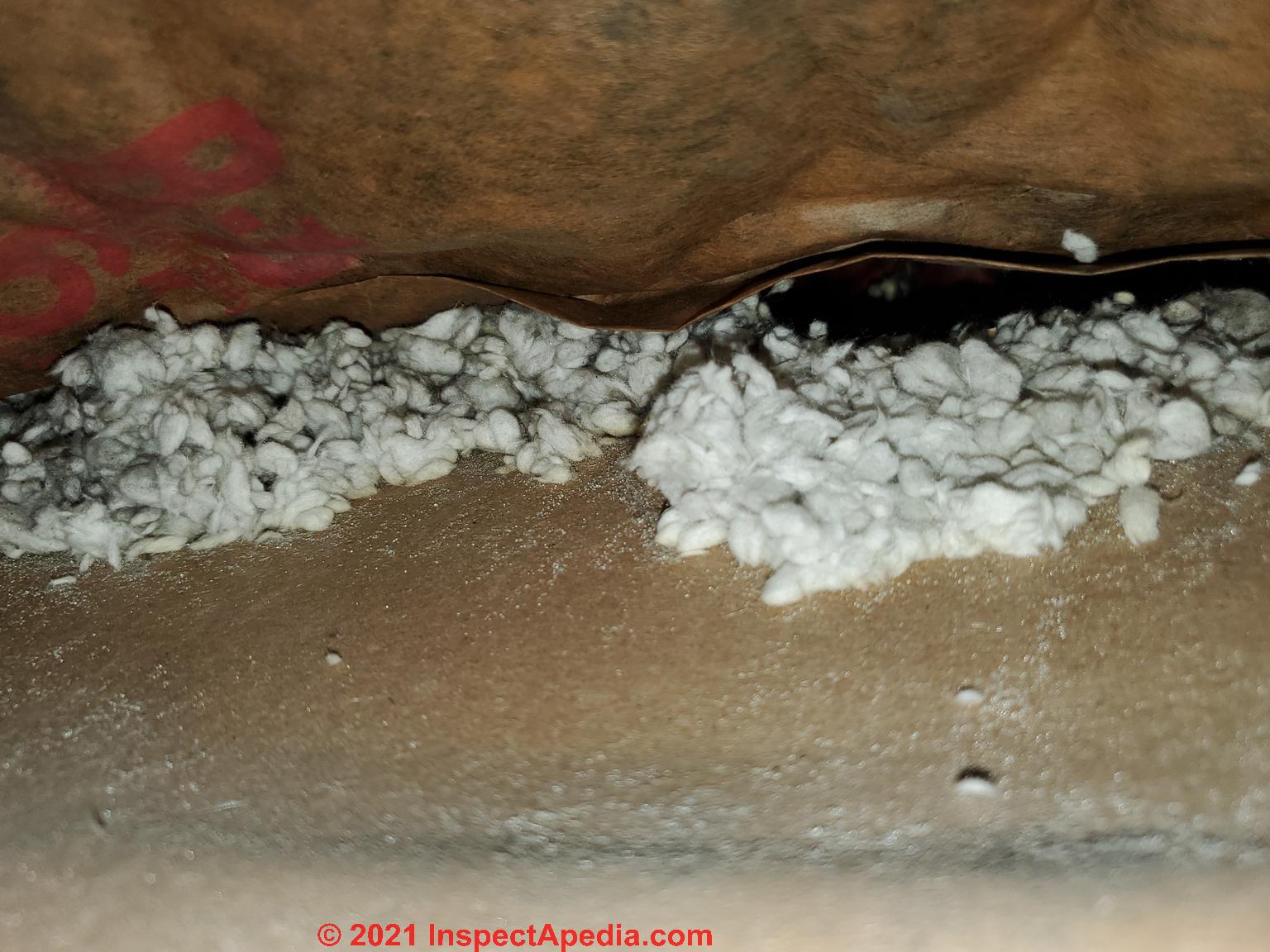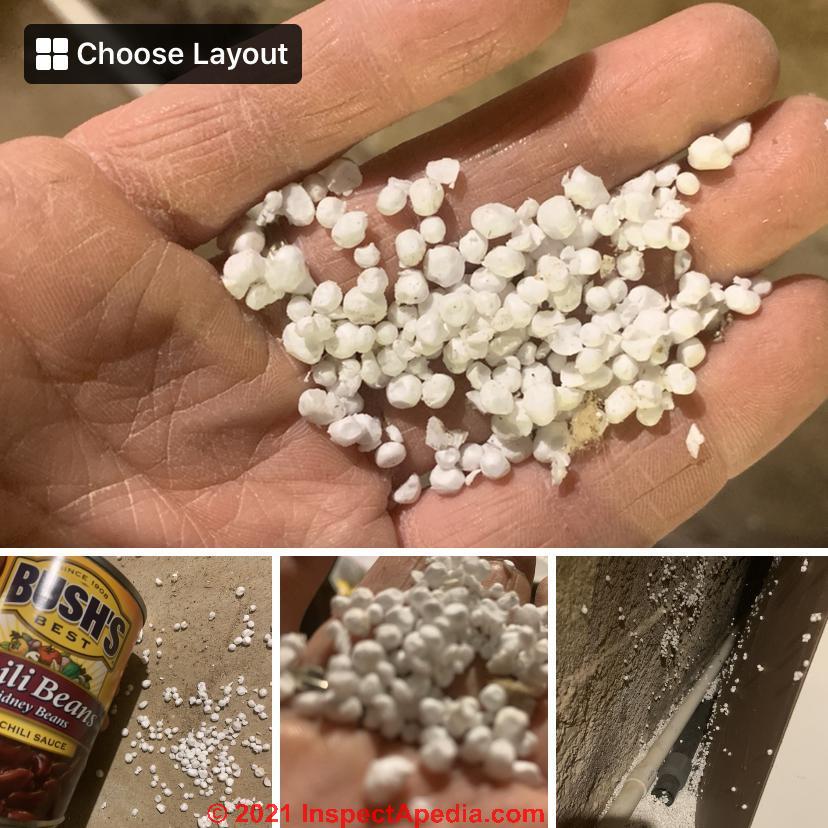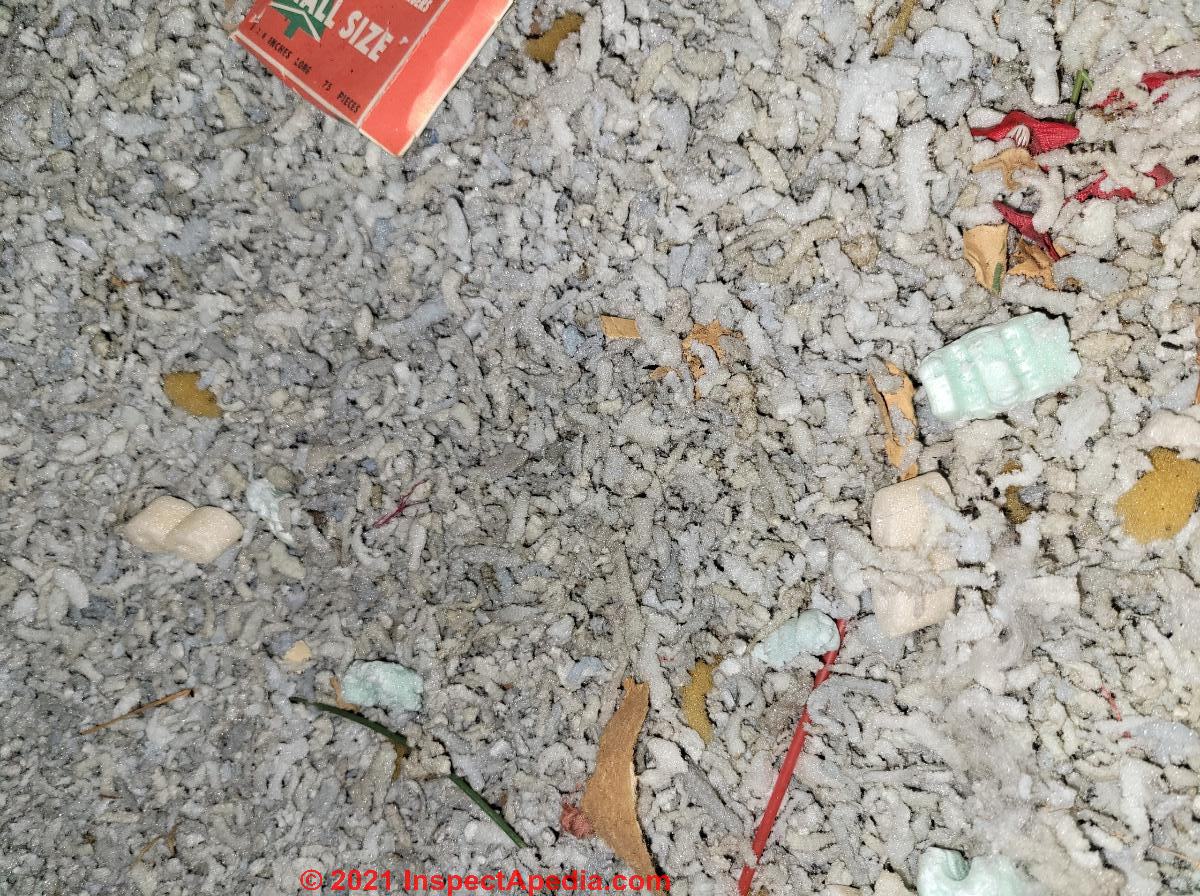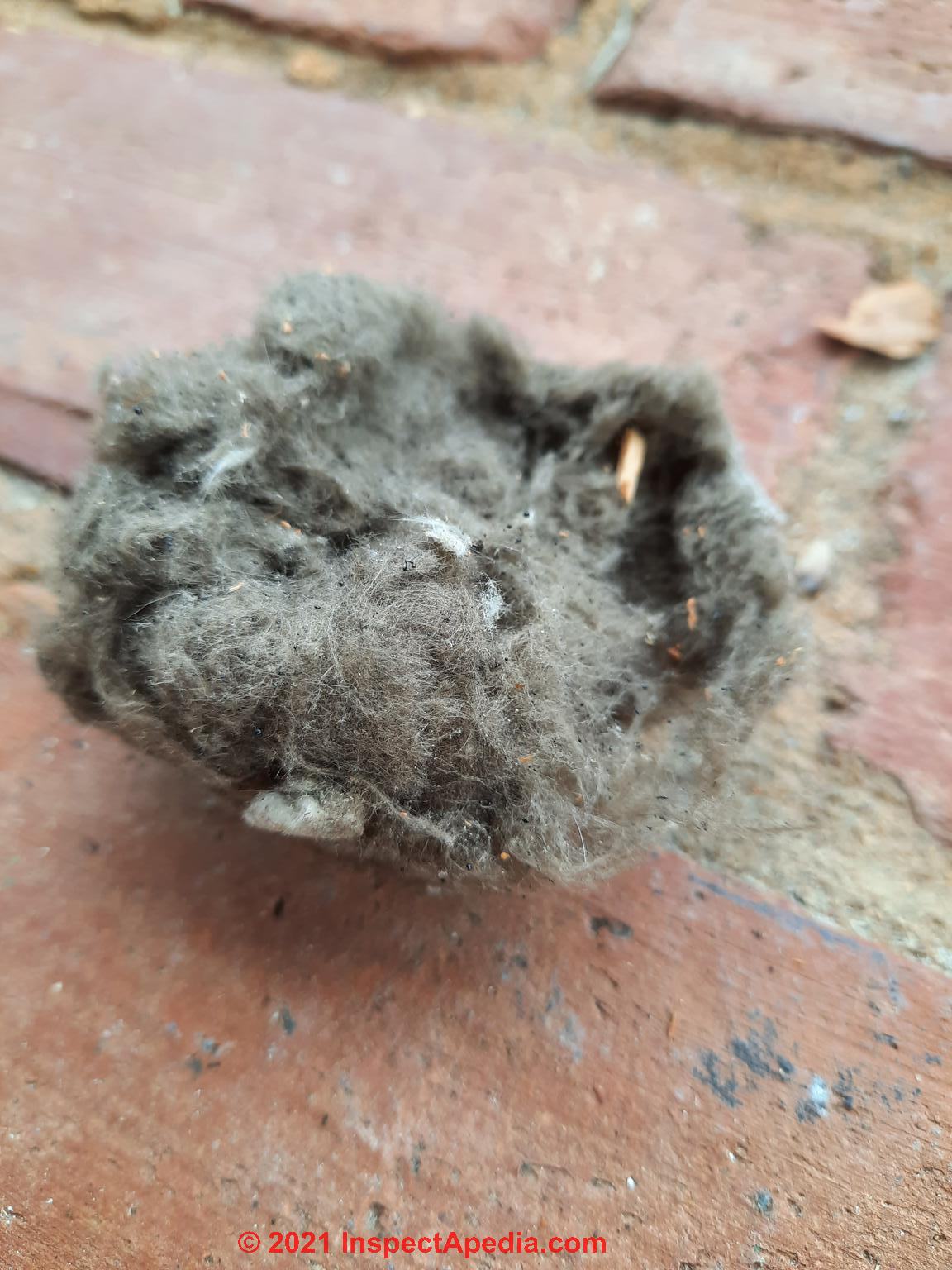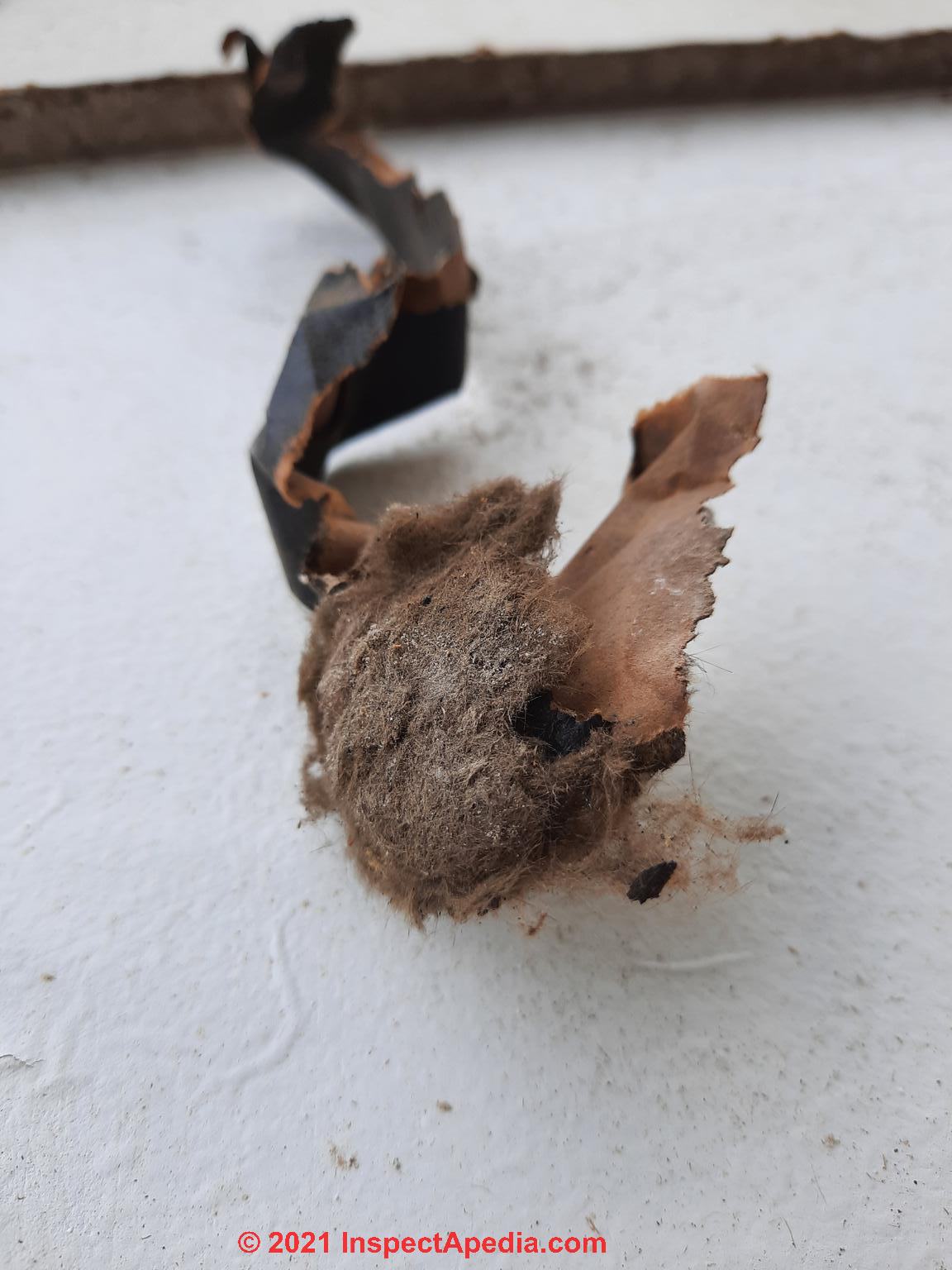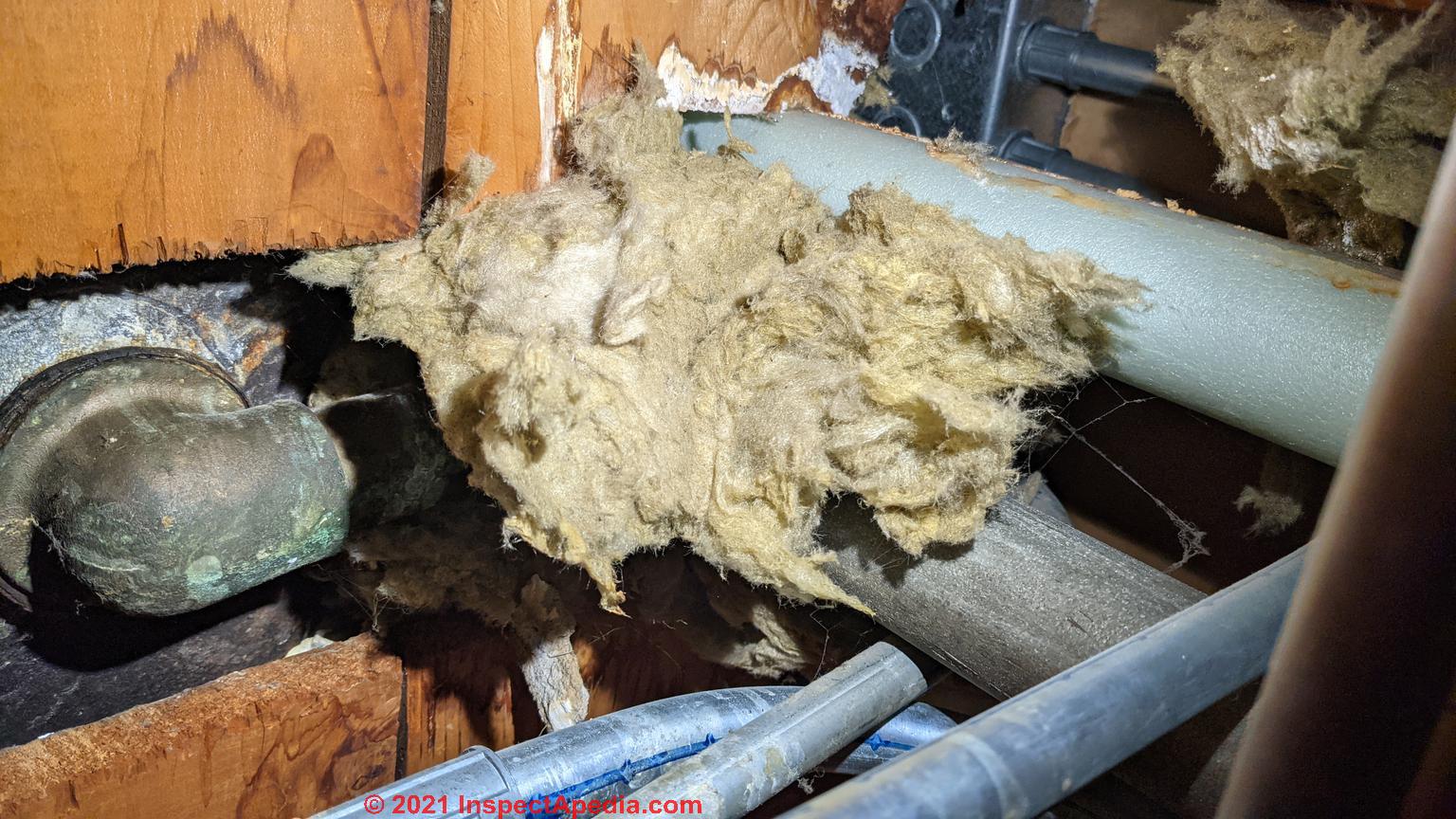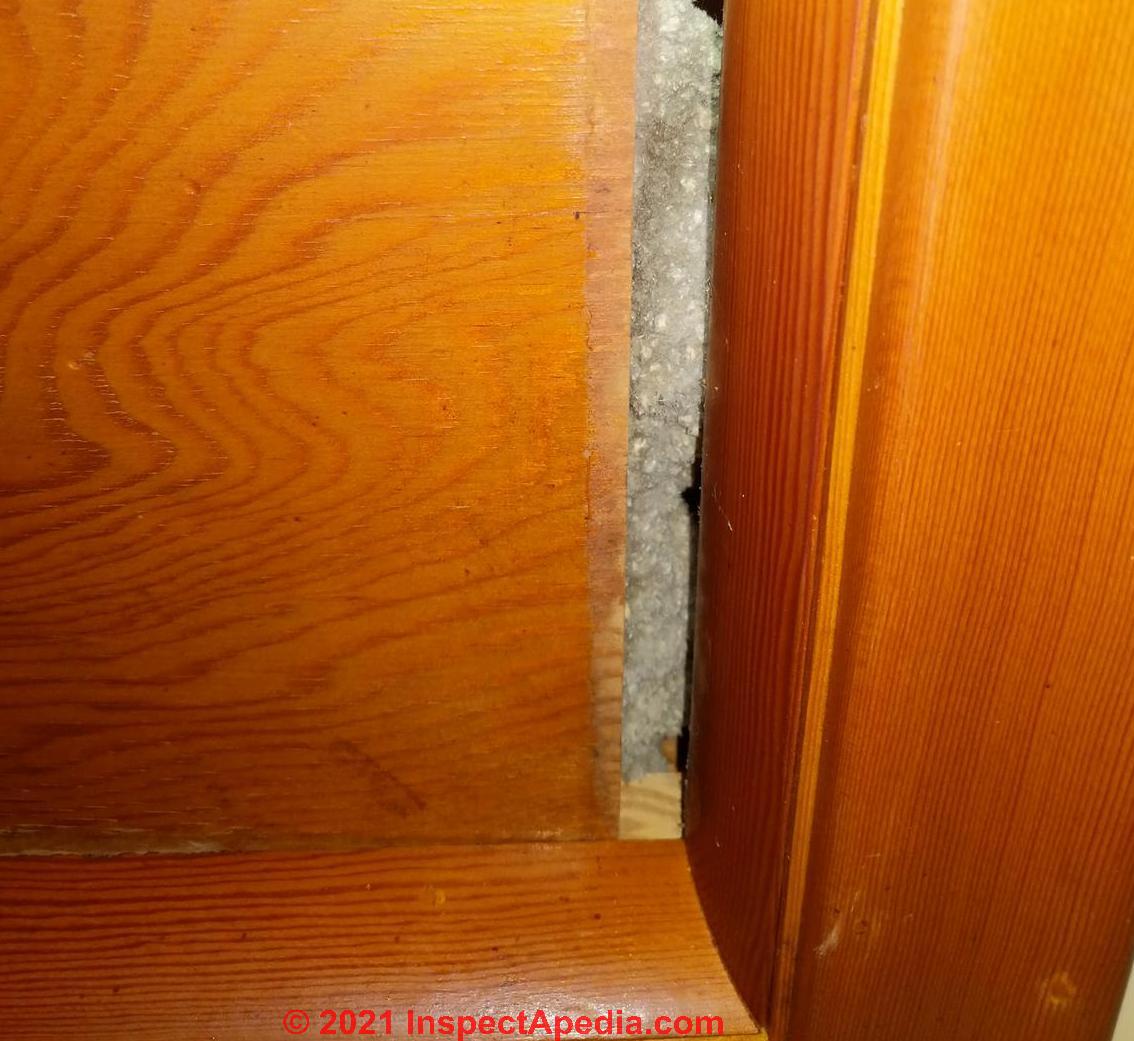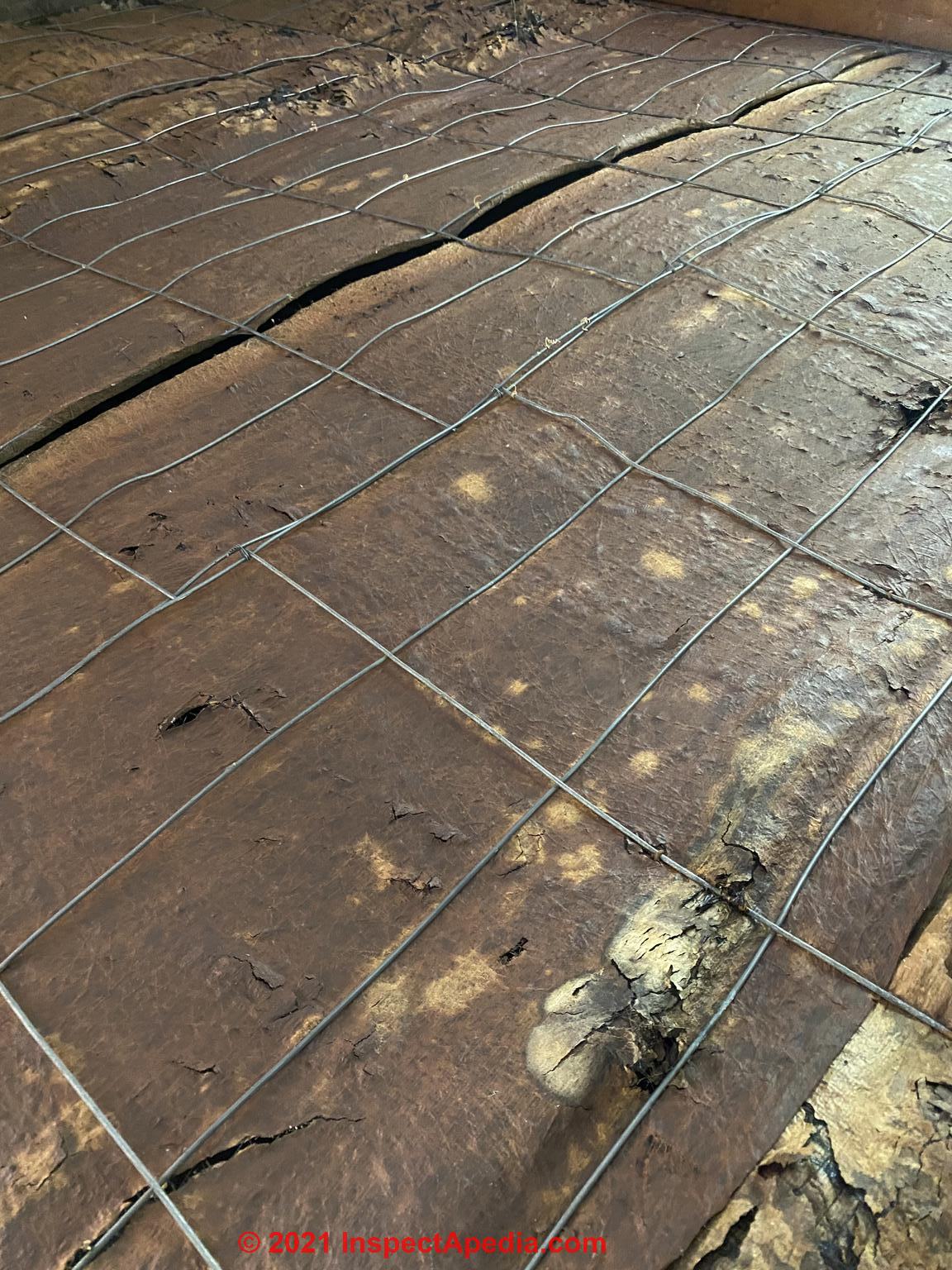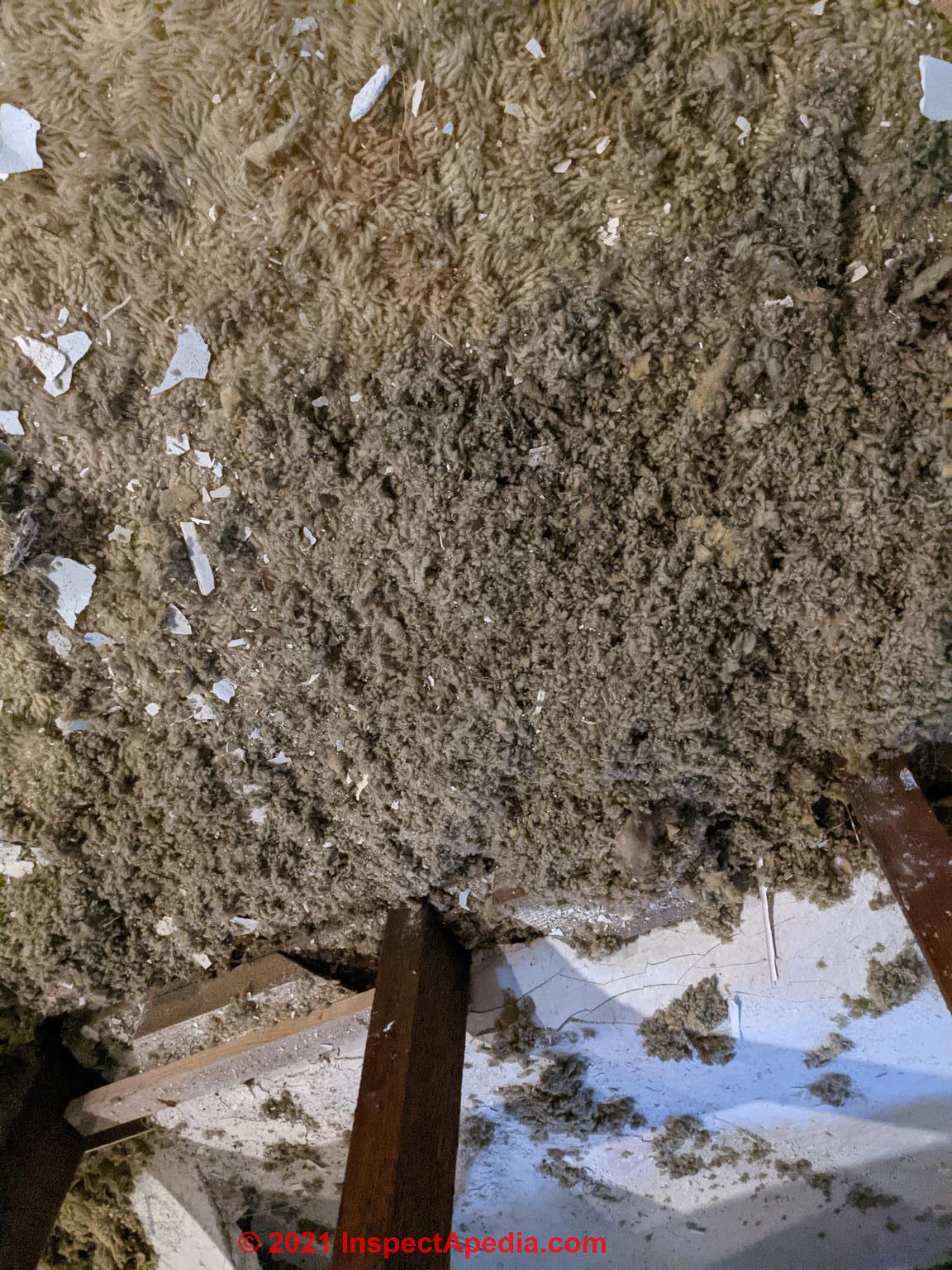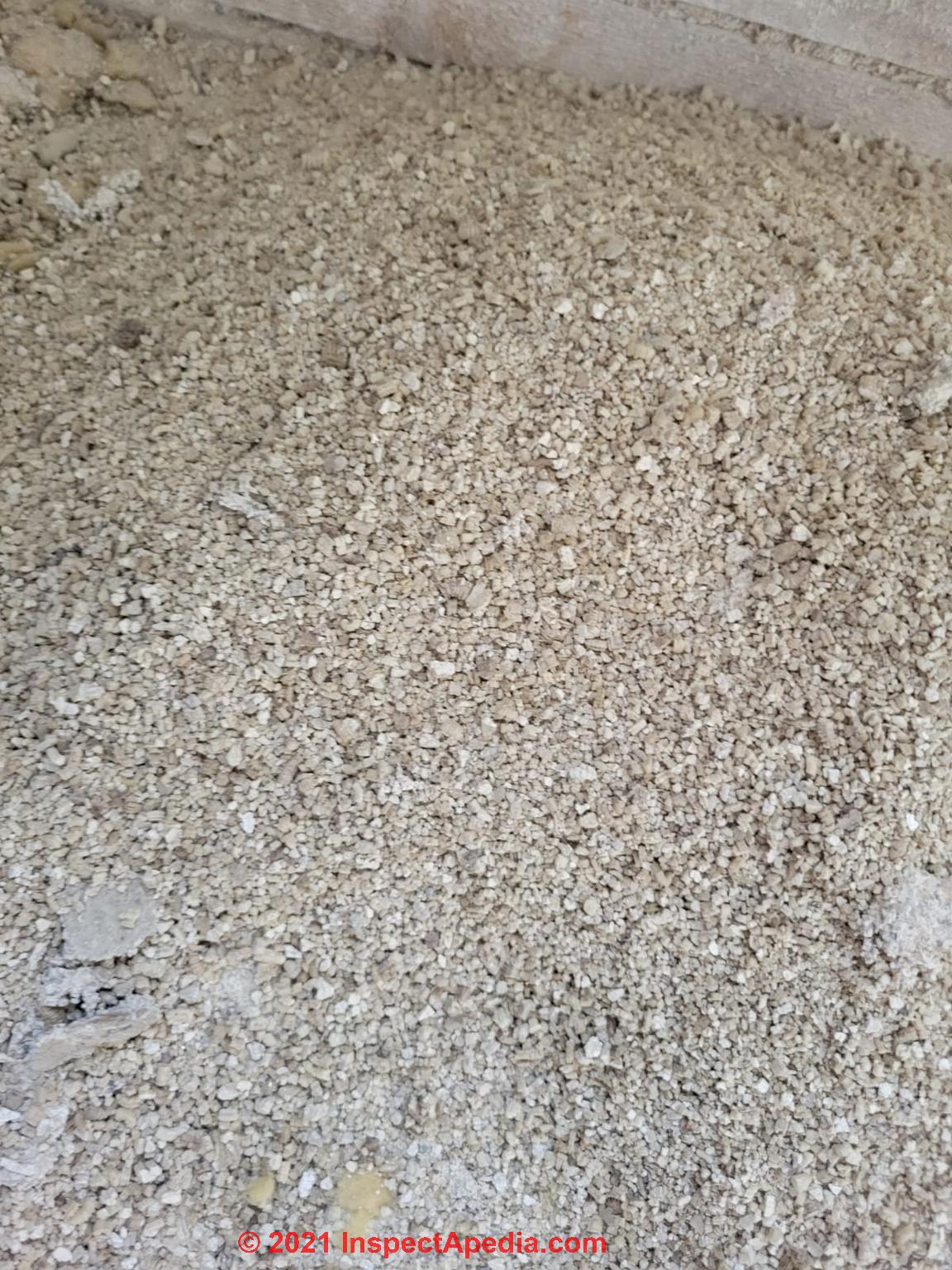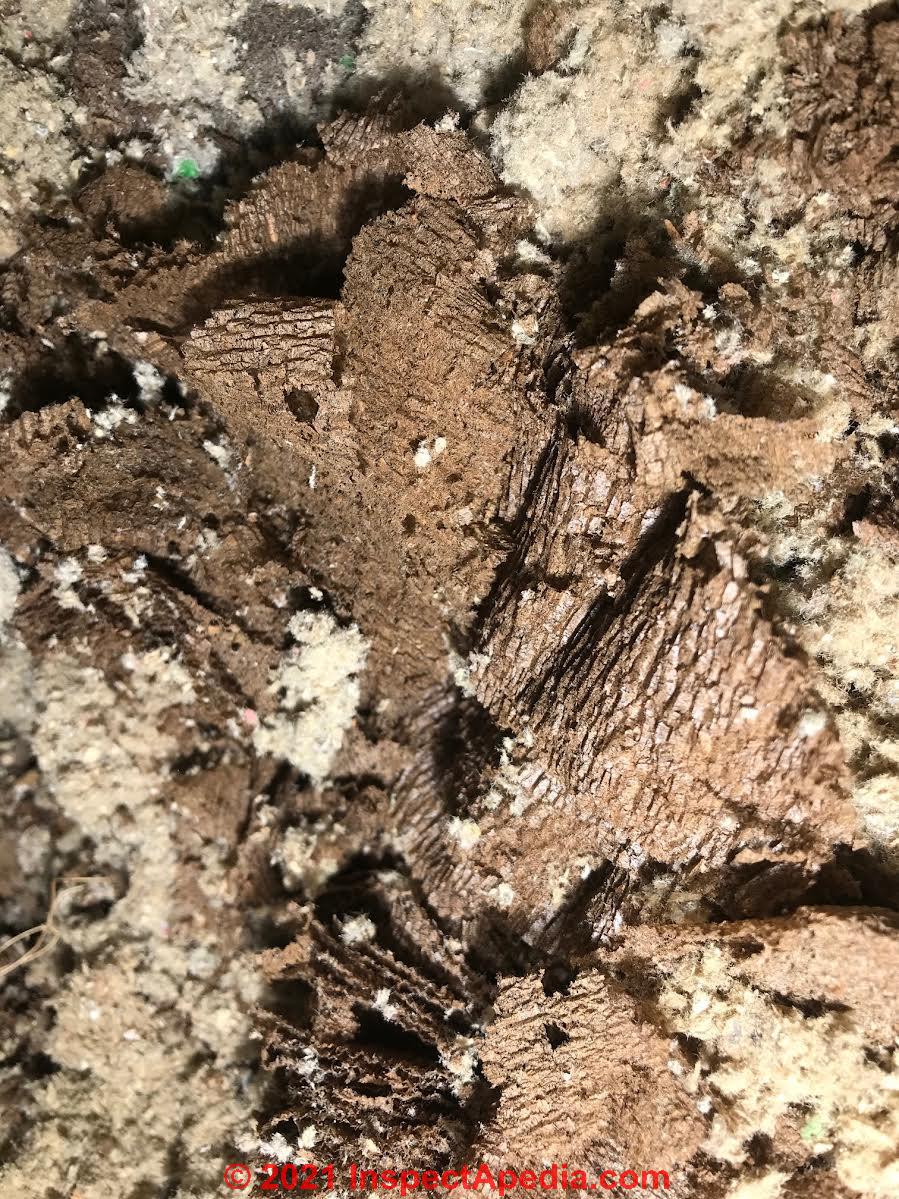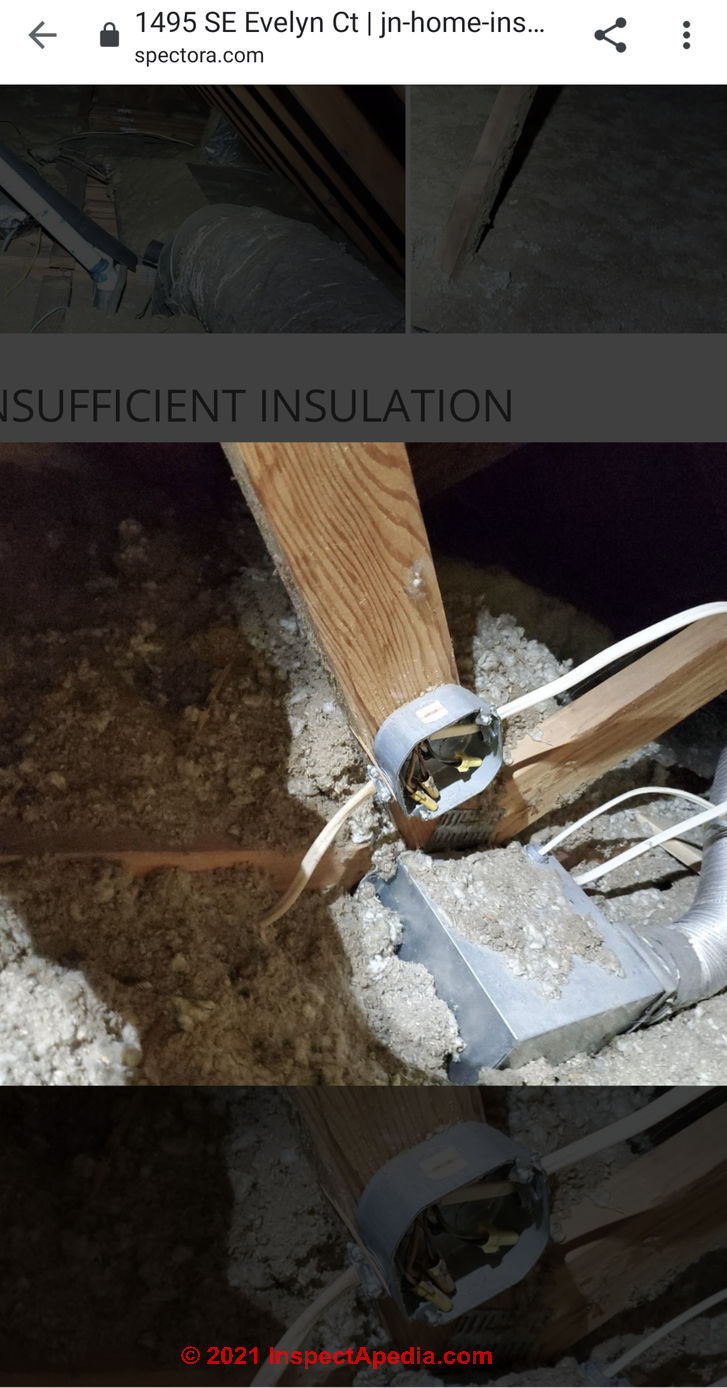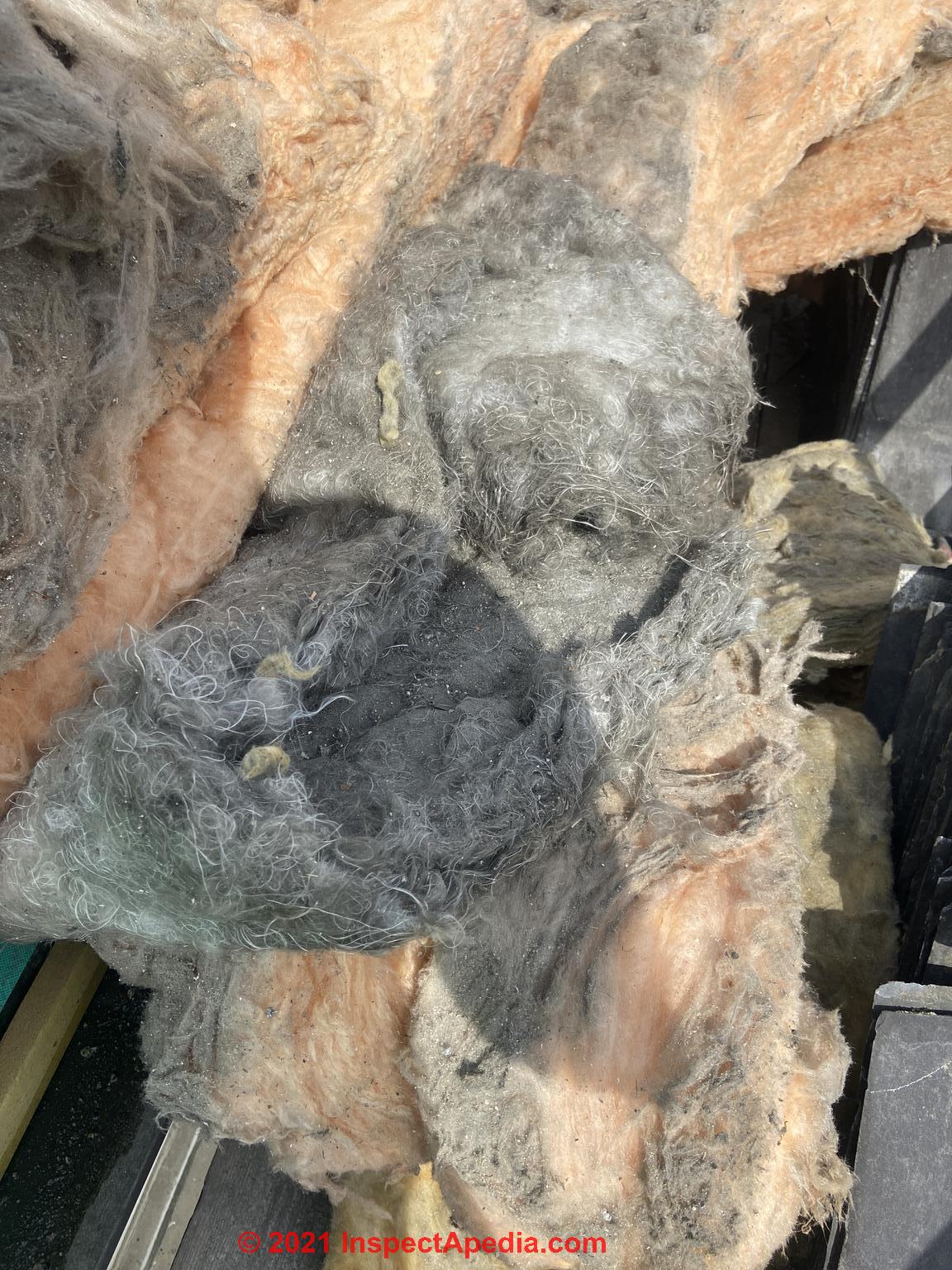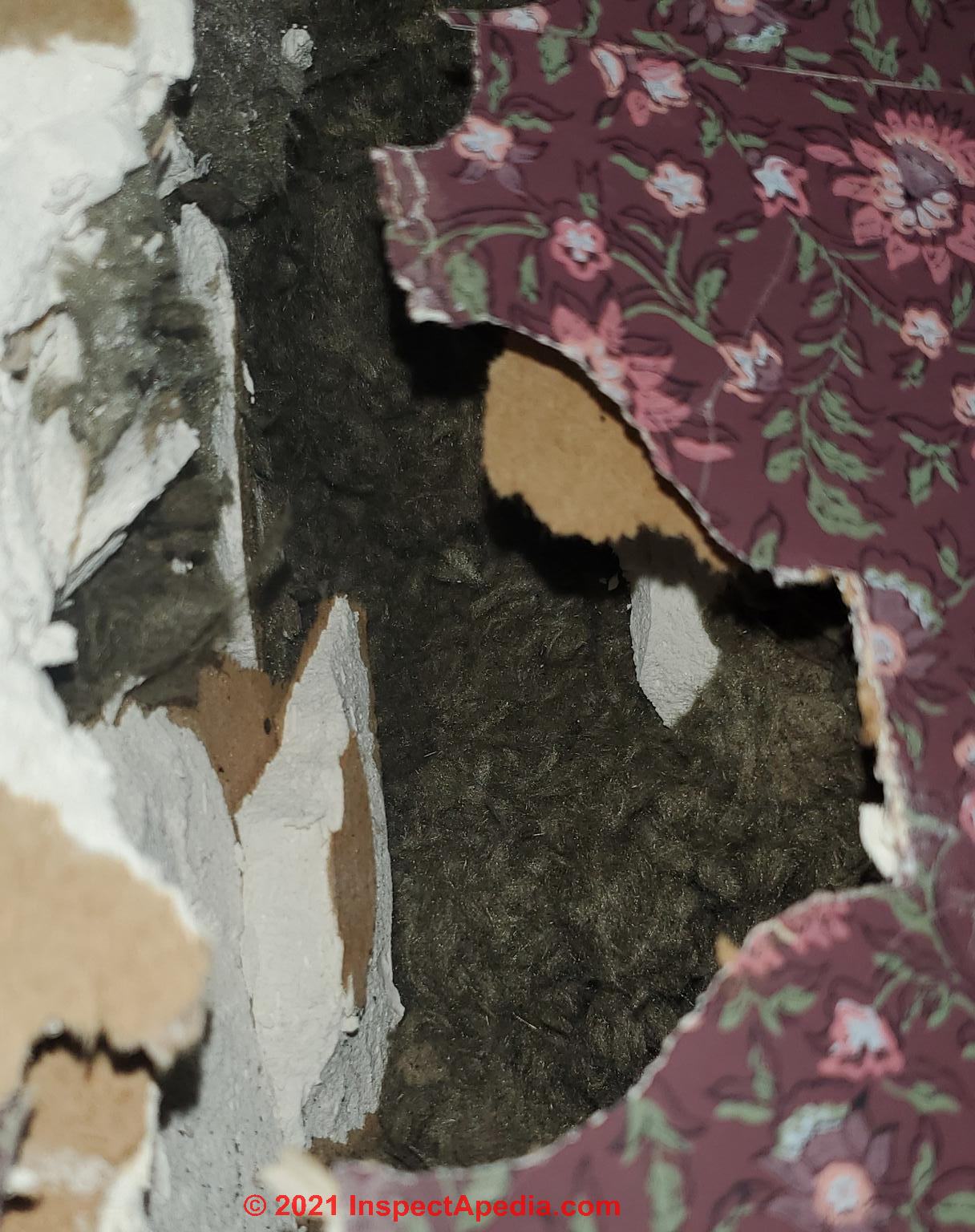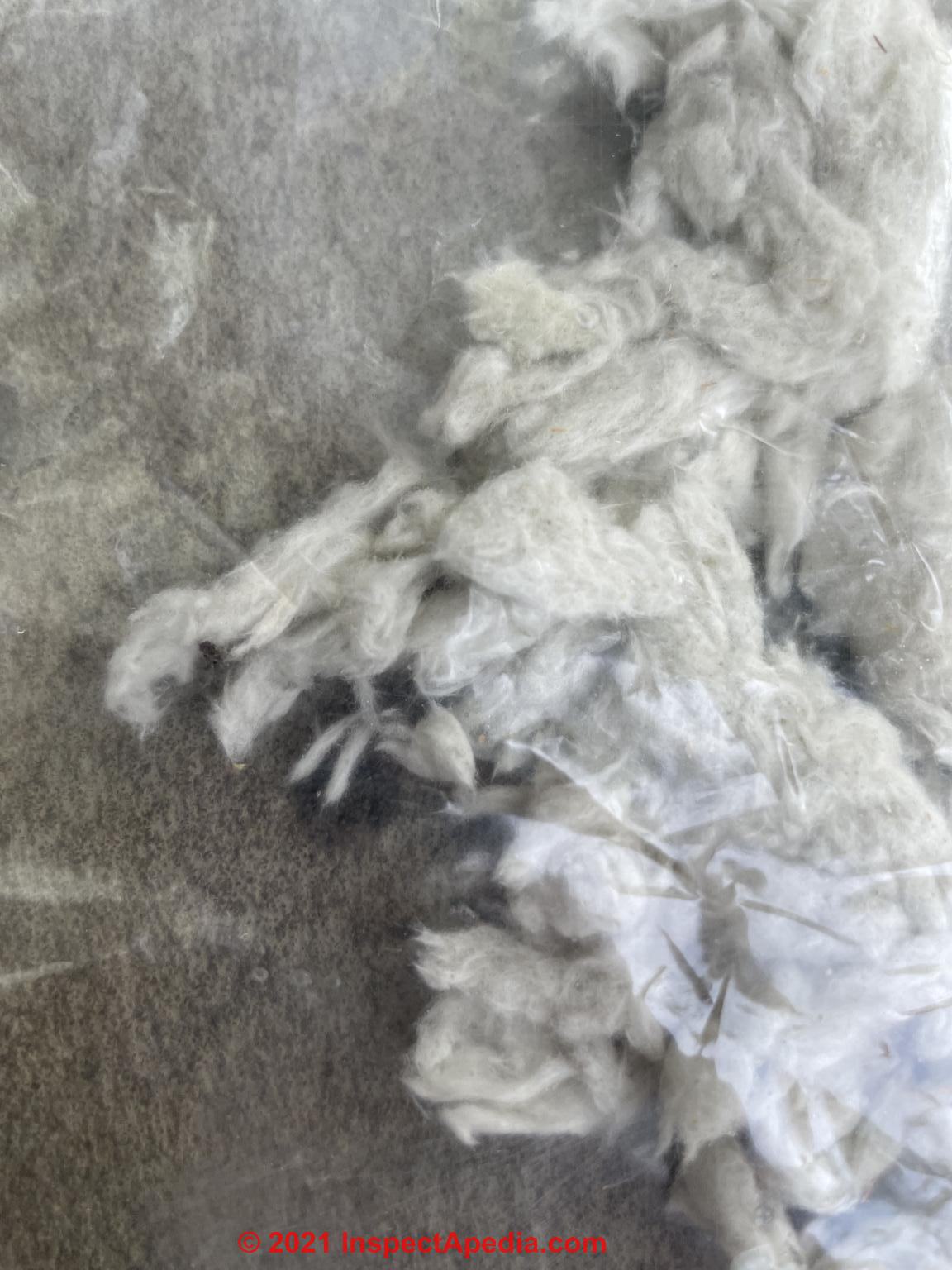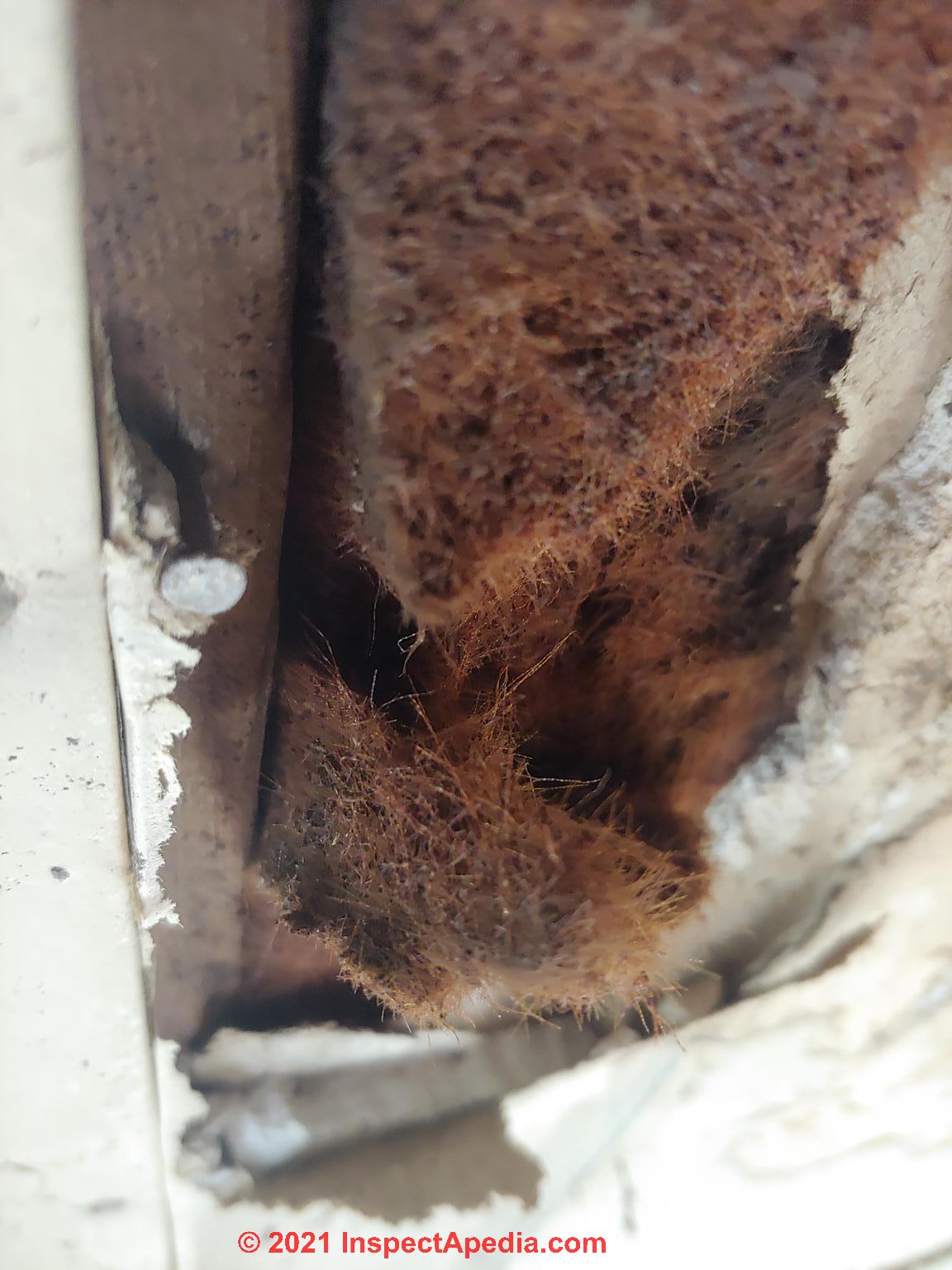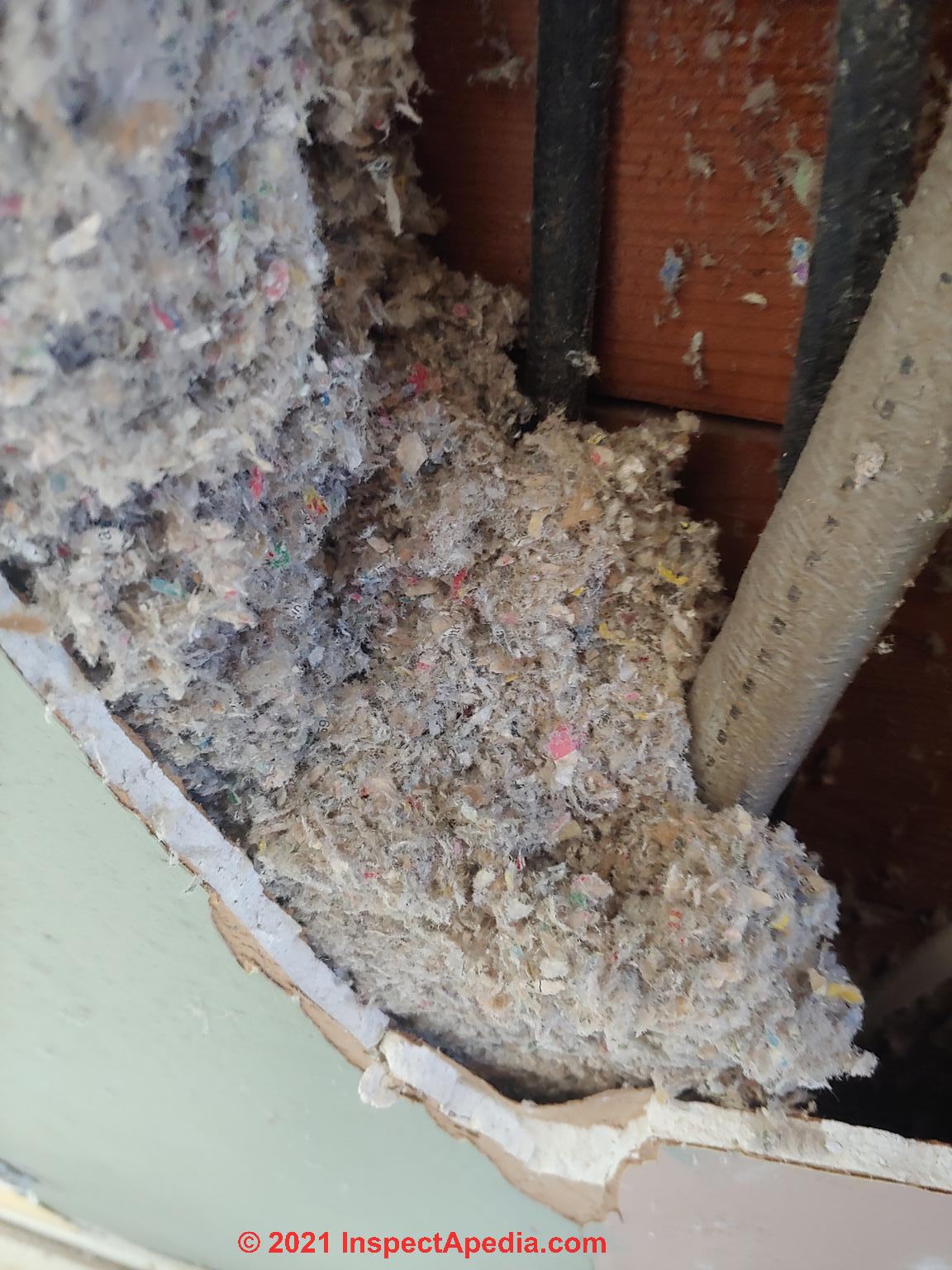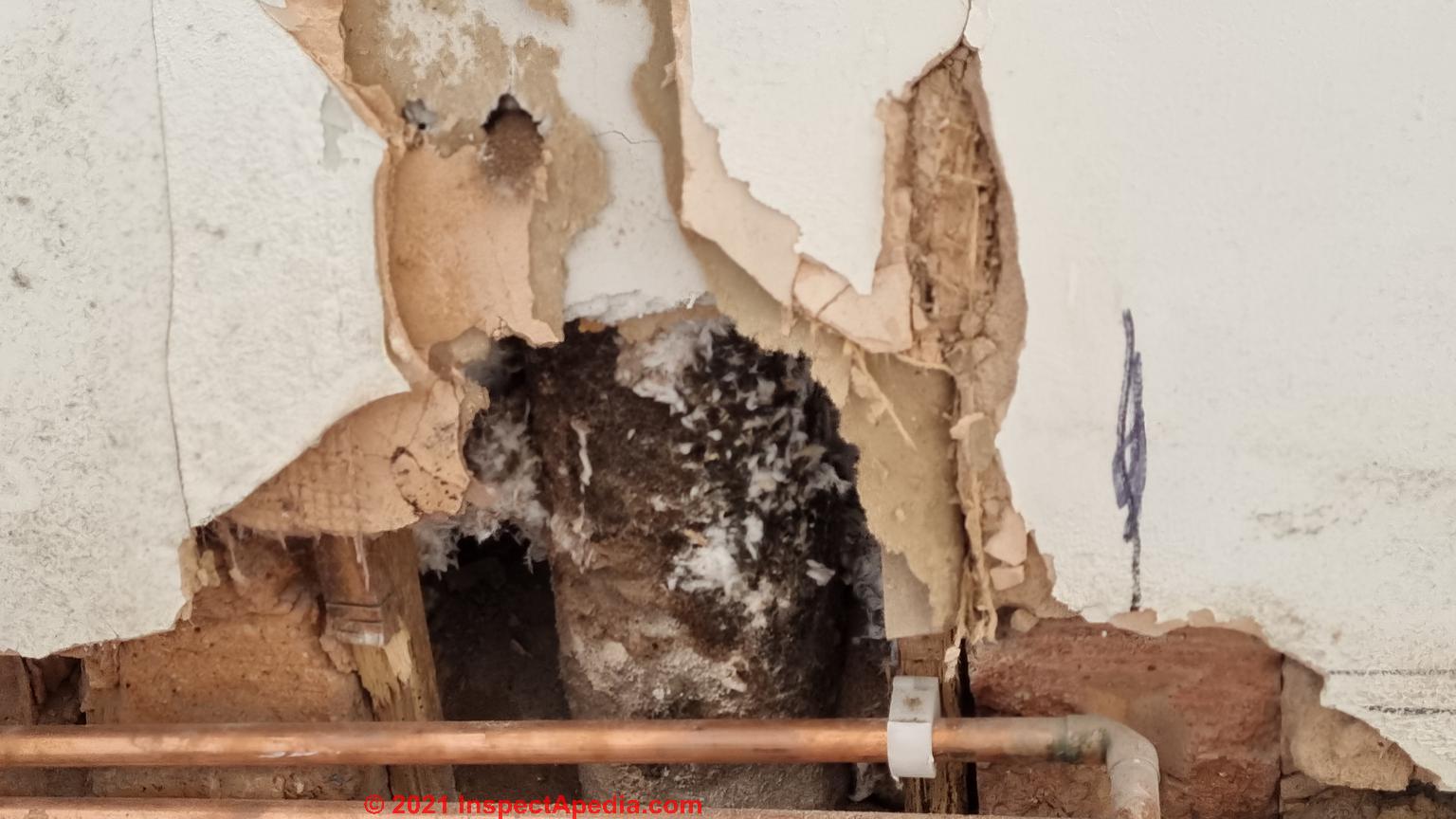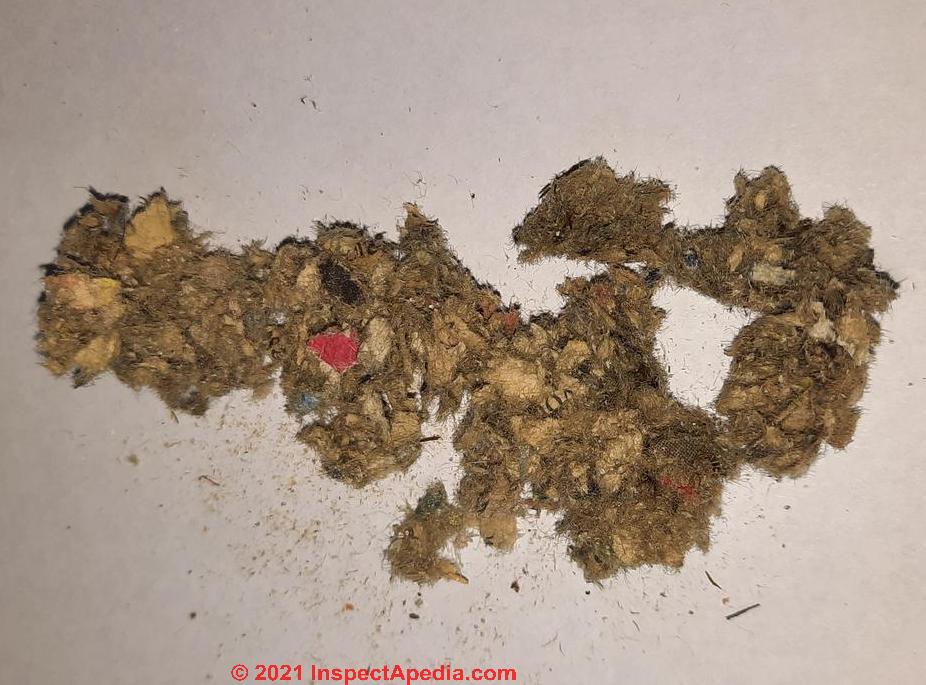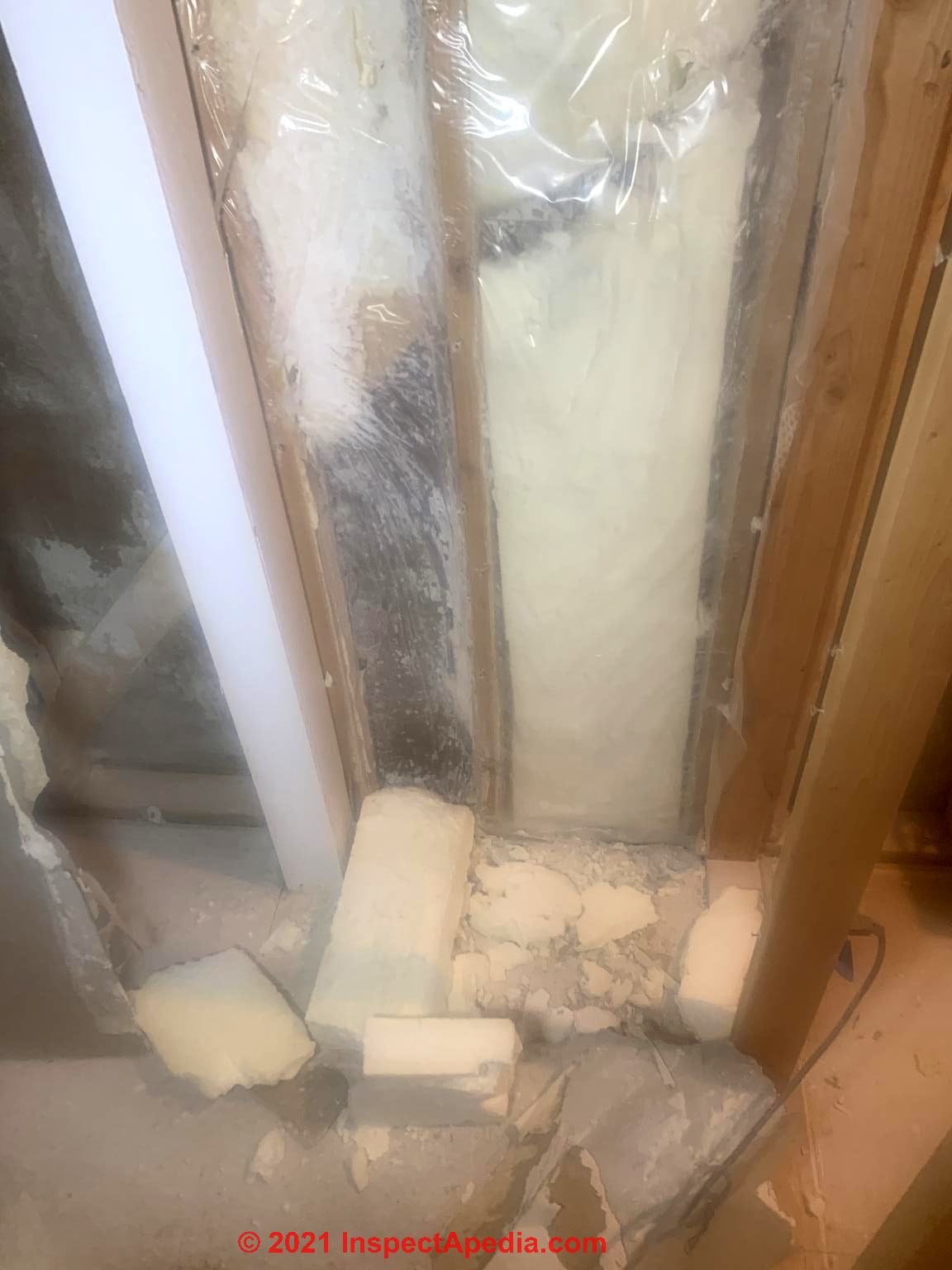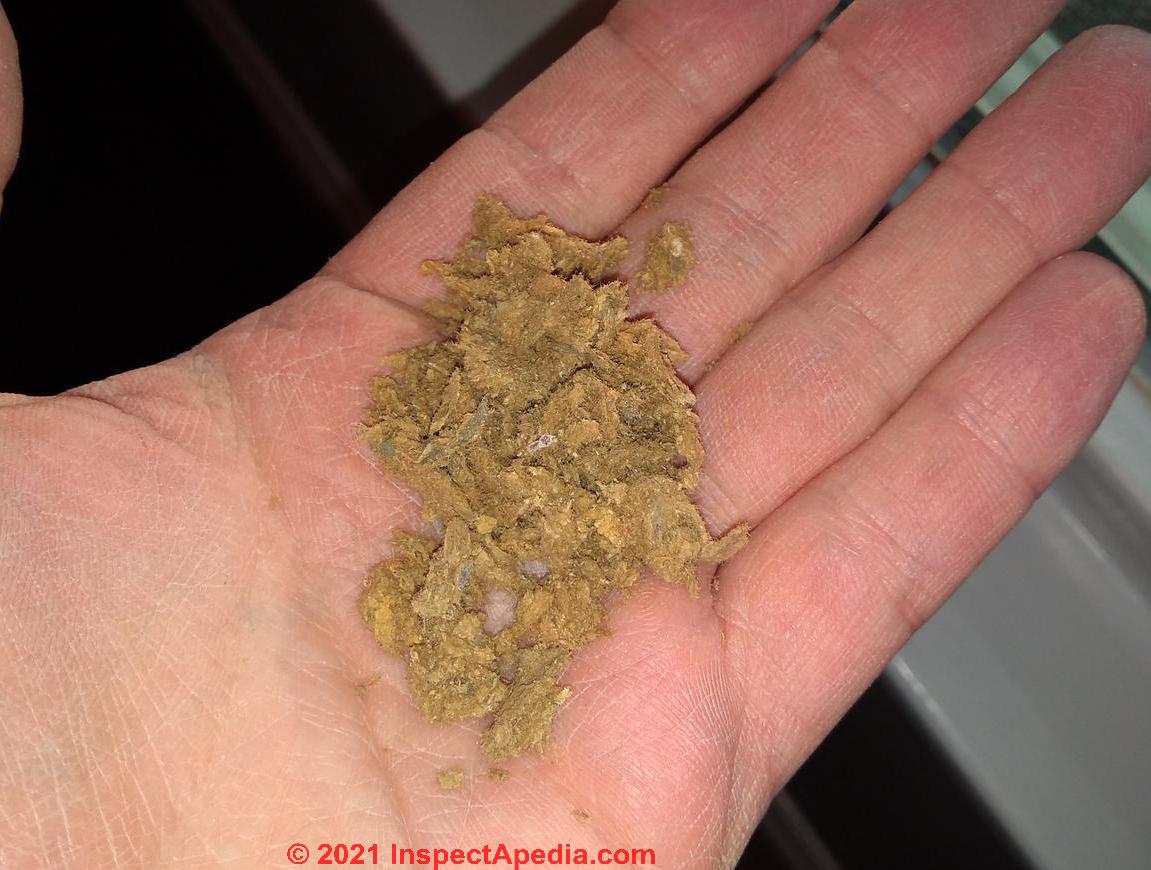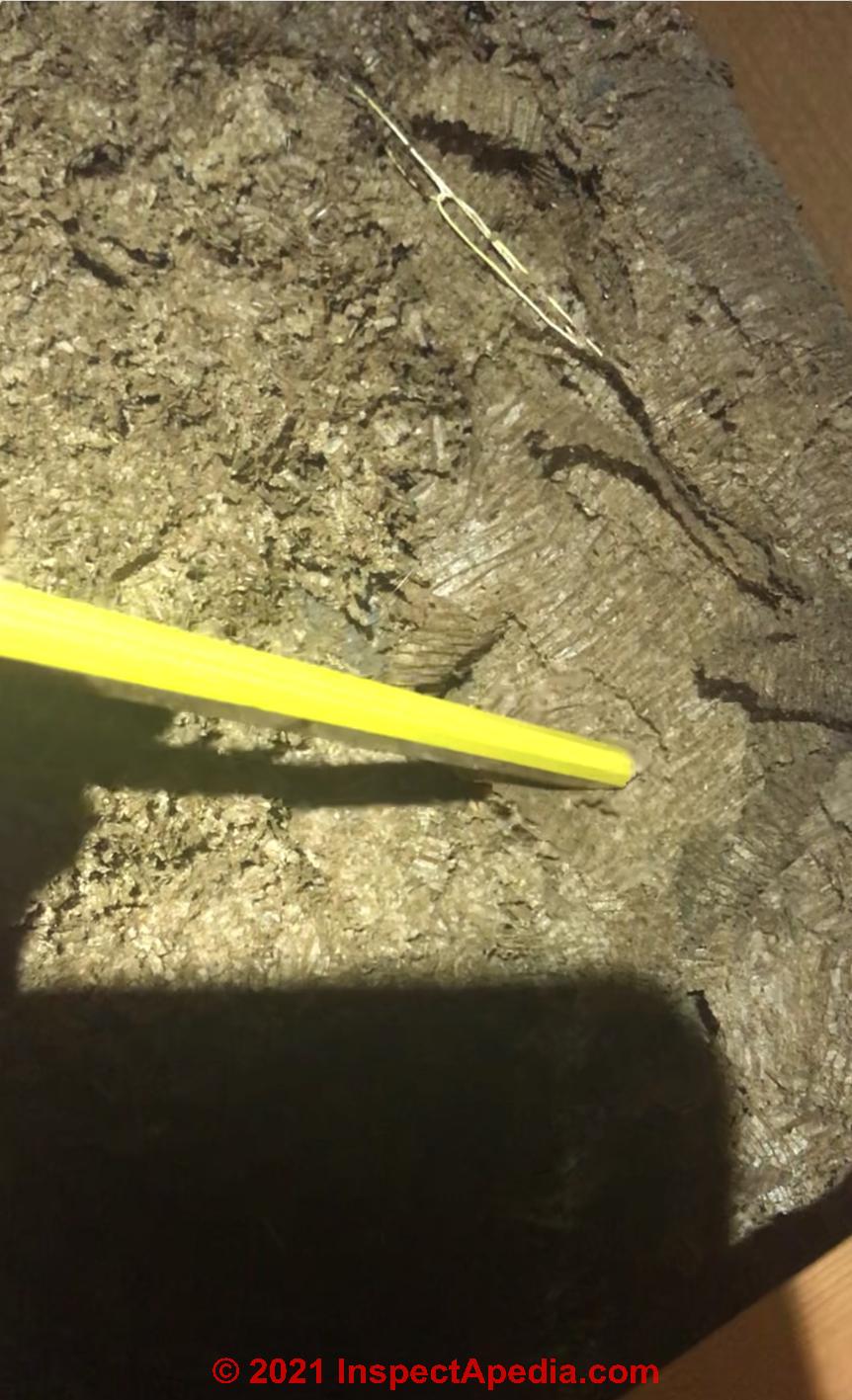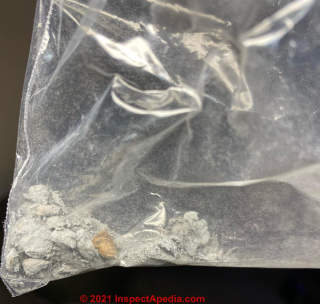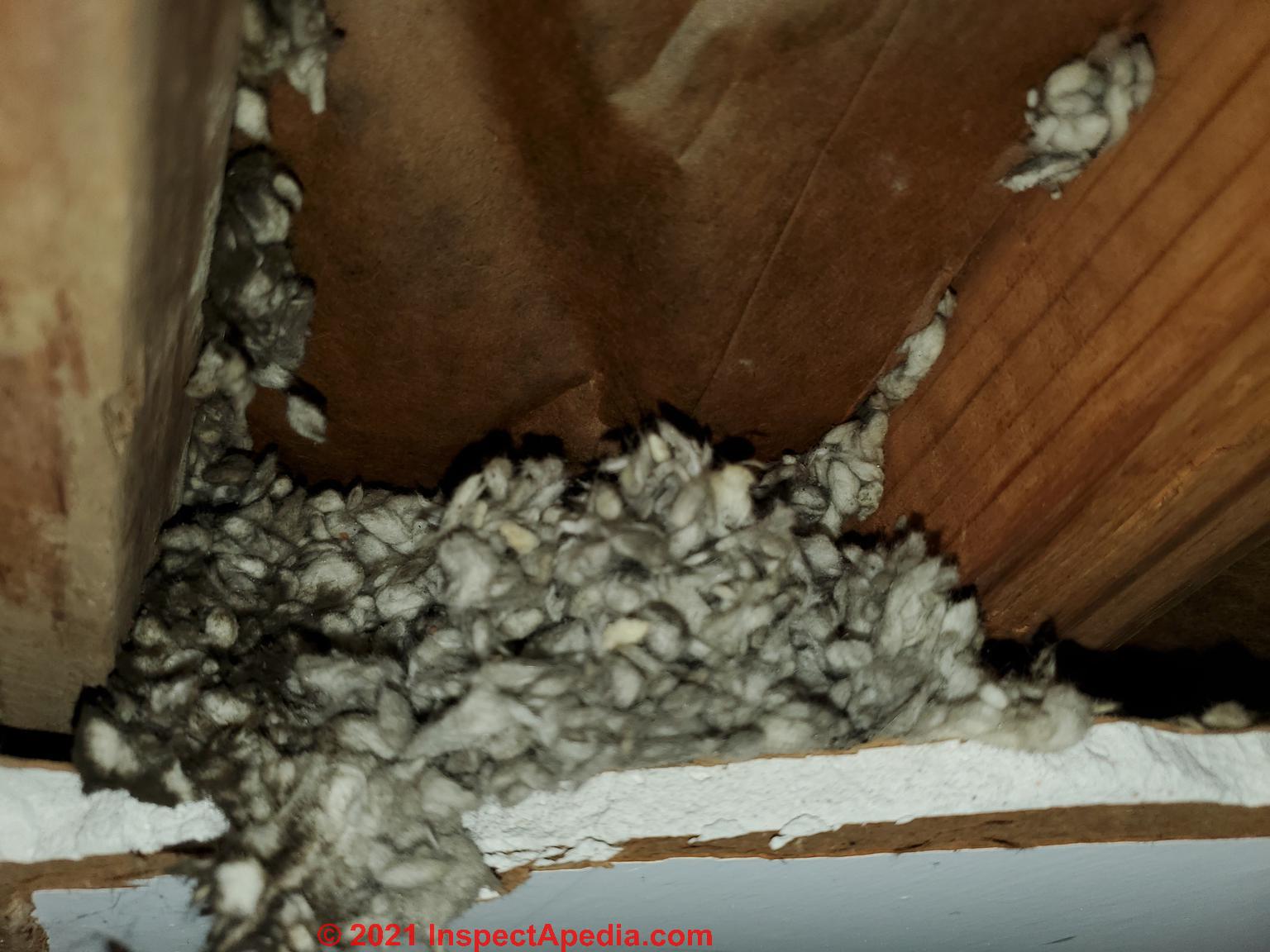 Insulation Identification FAQs #3
Insulation Identification FAQs #3
Q&A on how to identify building insulating materials
- POST a QUESTION or COMMENT about how to identify different kinds of building insulation
FAQs set #3 on how to identify types of insulation used in buildings & their mechanical systems:
Page top photo: Carey brand rock wool insulation in the attic of a 1940's home.
We illustrate and include photographs of insulation materials that would not be expected to contain asbestos as well as asbestos-containing materials.
InspectAPedia tolerates no conflicts of interest. We have no relationship with advertisers, products, or services discussed at this website.
- Daniel Friedman, Publisher/Editor/Author - See WHO ARE WE?
Q&A on How to Identify Insulation Materials #3 FAQs
 These questions & answers about identification of various kinds of building insulation by visual inspection were posted originally
These questions & answers about identification of various kinds of building insulation by visual inspection were posted originally
at INSULATION IDENTIFICATION GUIDE - be sure to see that article.
On 2022-11-03 by Bill Paulson - what is this attic loose fill insulation?
Found insulation that even home inspector didn’t recognize. 1927 single fam in Massachusetts.
[Photo above]
The insulation was in the attic among the floor joists covered by fiberglass. It looked like lumpy dirt.
I would have thought vermiculite but it didn’t have the shine. I have attached a picture.
We grabbed a handful and put it on some carpet in the attic.
On 2022-11-03 by InspectApedia-911
@Bill Paulson,
Your insulating material is a bit dark but a reasonable guess is Vermiculite building insulation.
See VERMICULITE INSULATION for comparison
Are the particles quite light-weight?
Are they varied in color?On 2022-11-04 by InspectApedia (Editor) - possible vermiculite in 1927 Massachusetts home
@Bill Paulson,
I agree that usually Vermiculite has some shiny particles, is flaky, and varies in color.
"Lumpy dirt" - is a bit baffling though it could be an unusual vermiculite product or even something less common like crumbled cork.
I'd like to see a sample of this material to examine in our lab - if you want to send some contact me by email. (No fee).
On 2021-12-20 by Worried - is this loose fill attic floor insulation asbestos? Horsehair insulation?
I am beyond worried.
This is insulation that came out of the wall that has been sitting in this hole in the floor open at a house I’ve been at quite a bit. I have kids and this just completely has me so worried because it’s wide open and they obviously run and play.
The homeowner also mentioned (after I started asking questions) that the attic may be completely loose fill gray stuff and he said he didn’t know but that it was probably asbestos which really has me coming unglued due to the in and out of his activity in the attic for Christmas decorations.
The home was built between 1890 and 1920.
The floors been ripped out down to some wood (where the photo shows) and he said also that the vinyl flooring he ripped up a couple layers in when he moved in about 5 years ago was probably asbestos due to the year.
I also saw crumbling plaster by the lath/plaster staircase.
He said he thought it was horsehair but from what I’m reading it very well may be asbestos. I feel like I’ve been surrounded by it and am worried to death about it now.
On 2021-12-20 by Inspectapedia Com Moderator
@Worried,
I can't tell for sure from the photo (it's a bit blurry at full size) what that insulation is
You'll want to compare your insulation with the materials shown at
VERMICULITE INSULATION
and also other common loose-fill insulating products
MINERAL WOOL, ROCK WOOL INSULATION
and
CELLULOSE LOOSE FILL INSULATIONOn 2021-12-20 by Worried
Is there a chance that they did loose fill blow in asbestos like they did in Australia (Mr. Fluffy) in Maine?
On 2021-12-20 by Inspectapedia Com Moderator - balancing worry, common sense, and facts
@Worried,
Take care: asking for an anecdotal answer to a big money or big liability question that has no supporting research, when you pose such to a consultant (did ANYBODY EVER do something foolish with Asbestos in Maine?) can cost you big money.
Beware that when you sound that concerned to many contractors and service providers it can cost you a lot of money, unnecessarily, as they'll find it easy to spend your money to reduce their risk (that they didn't give you aggressive-enough advice).
A fictional but nevertheless expert and smart medical forensic detective (Thorndyke) remarks in Richard Austin Freeman's (1862-1943) "The Vanishing Man ..."
... there is no use in speculating a priori; we should have to reconstruct a purely imaginary situation, the circumstances of which are unknown to us , and we should almost certainly reconstruct it wrong.
That's what our discussion here is being pressed to do.
We commented that we couldn't make out the insulation in a blurry photo.
You should seek objective, factual data: find and test representative insulation samples or, if it has been removed, settled dust that remains. Or if there is none, clean up (damp wipe, HEPA vacuum) and move-on.
Without that factual information further speculation and worry about the possibilities of leftover dust of an uncertain material of uncertain hazard at an unknown level are, with all due respect, simply not useful.
On 2021-11-26 by JTP - Carey's Rock Wool Insulation in a 1948 Ohio home
Home built in 1948 central Ohio.
It's located under Owens Corning Fiberglass Batts and some of it is very dusty/dirty to the point of being almost black.
Asbestos tile & adhesive was found on the basement floor. Can take more photos if needed. Thanks.
On 2021-11-26 by Inspectapedia Com Moderator
@JTP,
I'm guessing that your question was
what is the insulation in my photo?
It looks like rock wool or mineral wool.On 2021-11-28 by JTP
@Inspectapedia Com Moderator
Yes, apologies, I was asking for an ID of what it was.I found a box in the attic labeled Careys rock wool bat(the rest is ripped off).
Could this be remnants of that? Or is this rock wool loose fill? I had a friend of mine say it looked like fiberglass - hence my confusion. I've added another photo for good measure.
Some of the fluffs look yellow tinted. I don't know if this is due to dirt/aging. Worried about asbestos and plan to get it tested but the lab here is expensive.
On 2021-11-28 by (mod)
@JTP,
Yes, as I noted, that looks like "rock wool" or mineral wool insulation.
Please do post a photo of the Carey insulation box - photos showing all of the printed data would be helpful to other readers.
See details at MINERAL WOOL, ROCK WOOL INSULATIONIdentify this white pebbly insulation in my attic
Hello, can anyone identify this insulation? It is loose in my attic and falls out thru our ceiling panels and walls and has gotten into our basement as well.
It has the same or very similar weight and texture as styrofoam- at first I thought it was perlite but it’s not like a “rock” its much much lighter than that. Standard size can for size.
We have a farmhouse in rural Michigan built in the 1930s. We don’t know what it is or if we should pay to have it all sucked out of our attic, then replace with something else. THANK YOU!! :) - 2021-11-20 by Ruby -
Reply by Inspectapedia Com Moderator
@Ruby,
Rather looks like Styrofoam pellets.
Are they soft?
Can you mash them between two fingers?Followup by Ruby
@Inspectapedia Com Moderator, Wow thank you so much for the fast response. Yes, it looks just like styrofoam to me - I guess I didn’t realize styrofoam pellets were used.
No idea what year this may have been put in. Relatives said we should remove it all as its very flammable. Is styrofoam generally safe then (not containing asbestos or etc)?
Reply by Inspectapedia Com Moderator
@Ruby,
Where is the styrofoam used?
In board form it's widely used in buildings. Fire safety depends in part on its location.
Eg. Not left exposed in living space.
Followup by Ruby
@Inspectapedia Com Moderator, It’s in my attic and some has gotten above my ceilings (drop ceilings in an older home) as well. Its definitely not the board form type, its loose like in my photos.
It almost looks like decorative fake snowballs or something. I’m unsure how much there is as I haven’t seen it (attic) myself. Unsure if it was put in by an insulation professional or not.
My home was owned by an electrician who did most his own work, we think.
(There are so many light switches and outlets in my average sized house once in awhile I find a new one in some obscure place that I wasn’t previously aware of!)
Reply by Inspectapedia Com Moderator - Styrofoam pellets used for attic insulation? Fire barrier needed?
@Ruby,
Your observation, photos, comments, suggest that someone got a hold of a source of styrofoam pellets, probably intended for some other use, and decided to use them for his or her building insulation.
While this product does not exactly match typical foam or "plastic" building insulating materials (those are normally foam boards or sprayed-in/on foam insulation products) it is likely to be the same material as was used in styrofoam boards.
The fire barrier for ANY such insulation is required between the insulation and the living area - that is to say it is not required on the attic side of an attic space if that space isn't used as living space
Here is an example of a typically-pertinent building code that your local building inspector might considerExcerpts from New York City Building Code (2014) about Foam Insulation & Fire Safety
2603.3 Surface-Burning Characteristics
Unless otherwise indicated in this section, foam plastic insulation and foam plastic cores of manufactured assemblies shall have a flame spread index of not more than 75 and a smoke-developed index of not more than 450 where tested in the maximum thickness intended for use in accordance with ASTM E 84 or UL 723.
Loose fill-type foam plastic insulation shall be tested as board stock for the flame spread index and smoke-developed indexes.
Exceptions:
Foam plastic interior trim shall comply with the flame spread and smoke-developed indexes as provided for in Section 2604.2.
In cold storage buildings, ice plants, food plants, food processing rooms and similar areas, foam plastic insulation where tested in a thickness of 4 inches (102 mm) shall be permitted in a thickness up to 10 inches (254 mm) where the building is equipped throughout with an automatic fire sprinkler system in accordance with Section 903.3.1.1.The approved automatic sprinkler system shall be provided in both the room and that part of the building in which the room is located.
Foam plastic insulation that is a part of a Class A, B or C roof-covering assembly shall be exempt from the flame spread requirements of this section provided the assembly with the foam plastic insulation satisfactorily passes FM 4450 or UL 1256. The smoke-developed index shall not be limited for roof applications.
Foam plastic insulation greater than 4 inches (102 mm) in thickness shall have a maximum flame spread index of 75 and a smoke-developed index of 450 where tested at a minimum thickness of 4 inches (102 mm), provided the end use is approved in accordance with Section 2603.9 using the thickness and density intended for use.
Foam plastic interior signs in covered mall buildings shall not be required to comply with the flame spread and smoke-developed indexes of this section, provided the signs comply with Section 402.16.2603.4 Thermal Barrier
Except as provided for in Sections 2603.4.1 and 2603.9, foam plastic shall be separated from the interior of a building by an approved thermal barrier of 1/2-inch (12.7 mm) gypsum wallboard or equivalent thermal barrier material that will limit the average temperature rise of the unexposed surface to not more than 250°F (120°C) after 15 minutes of fire exposure, complying with the standard time-temperature curve of ASTM E 119 or UL 263.
The thermal barrier shall be installed in such a manner that it will remain in place for 15 minutes based on FM 4880, UL 1040, NFPA 286 or UL 1715. Combustible concealed spaces shall comply with Section 717 of this code.
2603.4.1.6 Attics and Crawl Spaces
Within an attic or crawl space where entry is made only for service of utilities, foam plastic insulation shall be permitted without thermal barrier if protected against ignition by 11/2-inch-thick (38 mm) mineral fiber insulation; 1/4-inch-thick (6.4 mm) wood structural panel, particleboard or hardboard; 3/8-inch (9.5 mm) gypsum wallboard, corrosion-resistant steel having a base metal thickness of 0.016 inch (0.4 mm) or other approved material installed in such a manner that the foam plastic insulation is not exposed.
The protective covering shall be consistent with the requirements for the type of construction.
---
There are other details that may need to be addressed, such as keeping insulation sufficiently far away from recessed or pot light fixtures, and not burning or hiding electrical components in the attic floor insulation.
More details:
Warning: yours is loose-fill pellets, probably never intended for building insulation, and so we won't find an installation specification. What's left is to look at the closest products we can find, such as styrofoam board insulation which would have similar properties.
Here is what Dupont, a manufacturer of Styrofoam says:
Cured foam is combustible and will burn if exposed to open
flame or sparks from high-energy sources. Do not expose to
temperatures above 240°F. Foam should not be used around
heaters, furnaces, fireplaces, recessed lighting fixtures or other
applications where the foam may come in contact with
heat-conducting surfaces. F
- source: Dupont, "Installation Procedures for Insulating and Air Sealing Interior Basement Walls" [PDF] retrieved 2021/11/23 original source: www.dupont.com/content/dam/dupont/amer/us/en/performance-building-solutions/public/documents/en/installation-procedures-for-insulating-and-air-sealing-interior-basement-walls-43-D100140-enNA.pdf
available at InspectApedia.com at
Styrofoam peanuts used as attic insulation?
What is this insulation just peanuts like the styrofoam kind?
On 2021-11-02 by Brandon -
Reply by (mod)
@Brandon,
your photo shows what looks like shredded foamWatch out: If that's used as building insulation it may be a fire hazard if not properly protected by a fire barrier material.
What's this gray insulation in a 1930's Georgia home?
Hi, I'm pulling down a plaster and lathe ceiling built in the early 1930s in southwest Georgia. Ran across a couple bits of this between some joists.
Then as I moved across the room I found a pair of joist that seem to filled with the stuff.
It looks like it may have had paper backing that has broken down over time.
Another picture including part of what I assume is the original backing.
Curious of your opinion. Thank you in advance. - On 2021-11-01 by Jackson -
Reply by (mod)
@Jackson,
The gray material looks mineral woolWhat would you say is the true color? Brown, tan, or gray?
On 2021-10-25 by Diane - Great information on insulation: what's this material under my bath tub drain?
Hi! Great info, keep it up. Can you tell me if this type of insulation is an asbestos prodcut?
Based on what I'm seeing in this guide, it seems to be (dusty) yellow fiberglass, but would love an experts opinion. Thanks.
Reply by (mod)
@Diane,
Mineral wool or fiberglass.
-Gray insulation in a 1959 house
Can anyone identify.
1959 build.
On 2021-09-22 by Jane
Reply by inspectapedia.com.moderator - cellulose insulation in 1959 home
@Jane,
I can't see much of that photo but perhaps you looking at cellulose insulation.
Wooly material insulation in a 1960's Australia home
Hello, I have a house in the 1960’s in Australia and in my garage there is some insulation which looks like paper with a wool like material through it.
Does anyone know what it is?
-On 2021-09-10 by Ian
Reply by inspectapedia.com.moderator
@Ian,
I can't actually see the insulation material itself in your photo but from what I can see I suspect that is Kraft paper faced fiberglass or mineral wool battingIndeed both Australia and New Zealand produced sheep's wool insulation used in some buildings.
Wool-like Insulation from 1950's or 1960's house walls in Sydney Australia
Found in wall cavities in a 50s-60s era house.
- On 2021-09-04 by Oz -
Reply by inspectapedia.com.moderator (mod)
@Oz,
That's not an insulation I can quite make out from the photo.
What are the country and city of location of the building?
Can you get a close-up sharp photo? Perhaps a type of cellulose?Looking on a larger screen it almost looks like carpet trimmings; perhaps this is a textile or plant fibre? Or sheeps wool?
Followup by Oz
@inspectapedia.com.moderator, thanks for your reply, I've attached another close-up shot.
The house is in Sydney, Australia - I'm worried that it may be Loose-fill asbestos, however to me personally it looks like some form of wool.On 2021-09-05 by inspectapedia.com.moderator- possible sheeps wool insulation in Australian home
@Oz,
It sure does. It could the mineral wool rather than sheep's wool but the shape of the clusters of fibers looks like carpet wool or sheeps wool. Have you tried taking a sample into a safe spot and seeing it's response to heat or a torch?On 2021-09-05 by Oz
@inspectapedia.com.moderator, not yet - I closed up in the event it was asbestos but will check the site out in the following week. I'm assuming asbestos would be heat-resistant?
On 2021-09-05 by inspectapedia.com.moderator
@Oz,
Nothing in that photo looks like asbestos.
Possible vermiculite insulation in a 1940's Canadian home in New Brunswich
Hello,
This was found behind plaster and lath walls in New Brunswick, Canada. The home was built in the 1940s. Seemed to be poured in.
Thanks for your help! - On 2021-08-19 by Krista -
Reply by inspectapedia.com.moderator (mod) - Vermiculite insulation in 1940s New Brunswick Canada Home
@Krista,
That looks like vermiculite insulation
Followup by Krista
@inspectapedia.com.moderator, @inspectapedia.com.moderator,
Thank you for your reply! Yes, that's what I was fearful of!Reply by inspectapedia.com.moderator (mod)
@Krista,
See VERMICULITE INSULATION for complete details and advice about what to do.
Paper-like insulation mixed with cellulose?
Hi there, this brown-colored insulation is below what seems to be blown-in cellulose throughout my attic. It looks layered, lightweight, and corrugated, and it is also paper-like.
I was wondering if it is some sort of cellulose insulation that you may have seen before? I want to confirm that it is not asbestos-based.
- On 2021-08-16 by Trent -
Reply by inspectapedia.com.moderator
@Trent,
That does look like a type of cellulose-fibre material. combined with older crepe paper insulation.
What are the country and city and age of the building where this is is installed?Followup by Trent
@inspectapedia.com.moderator,
it is a mid-40's home in east Tennessee
On 2021-08-17 by inspectapedia.com.moderator (mod) - brown crepe paper like insulation, 1940s, Tennessee
@Trent,
That insulation and building age and location would be consistent with some early forms of what was essentially a very thin multi-layered brown crepe paper type insulation, basically a wood or vegetable fiber or cellulose fiber product.I think the more modern-looking blown-in cellulose in the same photo is newer.
Brown crepe paper isn't asbestos.
On 2021-08-03 by Stacey W - Probable cellulose insulation
We recently changed our bathroom fan, and in the process my boyfriend got insulation everywhere. Does this just look like cellulose?
Reply by inspectapedia.com.moderator (mod)
@Stacey W,
Yes, cellulose insulation.Watch out: I see in your photo a note that suggests someone says "Insufficient Insulation" - which may not be the case: you do not want to bury electrical boxes in insulation,
and also there are electrical and safety hazards in your photo like that open electrical box.
Followup by Anonymous
@inspectapedia.com.moderator, so the likelihood of this containing asbestos is small you think?
Reply by inspectapedia.com.moderator (mod)
@Stacey W,
Right
Gray and pink fiberglass insulation: air bypass leaks?
What type of insulation is this? Is this asbestos - On 2021-07-28 by Kyran sharlotte -
On 2021-07-28 by (mod) - not asbestos
@Kyran sharlotte,
That looks like fiberglas insulation. See FIBERGLASS INSULATION h
The black or dark areas may be stains left by air bypass leaks.
Mineral wool in the fir-down space over a bath
We are doing some renovation in our home. Came accross this insulation in a furdown (or soffit) above our shower.
We are hoping to remove this portion to create a taller new shower. Should we be concerned that the insulation contains asbestos? - On 2021-07-19 by Pamela
On 2021-07-19 2 by inspectapedia.com.moderator (mod) - mineral wool isn't asbestos
@Pamela,
The photo is a bit blurry but that looks like mineral wool insulation- read that description in the article above.
For other readers: "fur down" sometimes written as furr-down or even "fir-down" derives from a building practice using furring strips in construction to create a dead air space; it's often used to describe a soffit space.
White fibrous insulation ID
What insulation does this look like? It will melt under a torch (small pie almost vanished) but larger pieces seem more resistant. - On 2021-07-05 by Jordan -
Reply by (mod)
@Jordan,
Possibly white fiberglass;
See https://inspectapedia.com/insulation/Fiberglass_Insulation_Identification.php FIBERGLASS INSULATION IDENTIFICATION & PROPERTIES
and in that article specifically look at WHITE FIBERGLASS INSULATION https://inspectapedia.com/insulation/Fiberglass_Insulation_Identification.php#White
Where we'll include your photo and question to invite further reader comment
it looks to light to be mineral wool - another possibility; perhaps more-likelySee MINERAL WOOL - ROCK WOOL INSULATION
And cotton, even treated with a flame retardant, ought not melt.
Brown fibrous insulation: balsam wool in ceiling of a 1945 Pacific Northwest home
After opening the bathroom ceiling of this Pacific Northwest USA 1945s home, I saw this insulation. Can you identify it? Does it contain asbestos?
coachbennett9@gmail.com 503-473-5989 - On 2021-06-17
by Eric Bennett
Reply by inspectapedia.com.moderator (mod) -
@Eric Bennett,
Not with certainty from your photo but take a look at the BALSAM WOOL discussion linked-to from the top of this pageFollowup by Eric Bennett
Thank you for your last response. How about this. It was probably blown in after the construction of b the 1945 Pacific Northwest home. Asbestos?
Reply by inspectapedia.com.moderator (mod) - cellulose ceiling insulation, Pacific Northwest home
@Eric Bennett,
That's cellulose insulation- you'll also find that illustrated and described above on this page and there we link to more information about that insulation type
ID the Insulation ina 1960's UK home wall - Asbestos?
A plumber came in to change old radiators and chase in new pipework in an early 60s UK house.
After removing the brackets some of the wall fell away leaving the scene in the picture.
Are there likely to be any asbestos in the materials pictured? - On 2021-05-22 by Tom
Reply by (mod)
@Tom,
the photo is a bit blurry but I think I see both white and gray fibrous insulation, perhaps mineral wool. Try for a closer, sharper image and we may be able to have a more-confident identification of your 1960s UK insulation.What's this insulation in a 1934 home's plaster wall?
Any thoughts what type of insulation is in this photo behind the plaster/drywall? Sorry the photo is not very clear. 1934 home. Thanks!
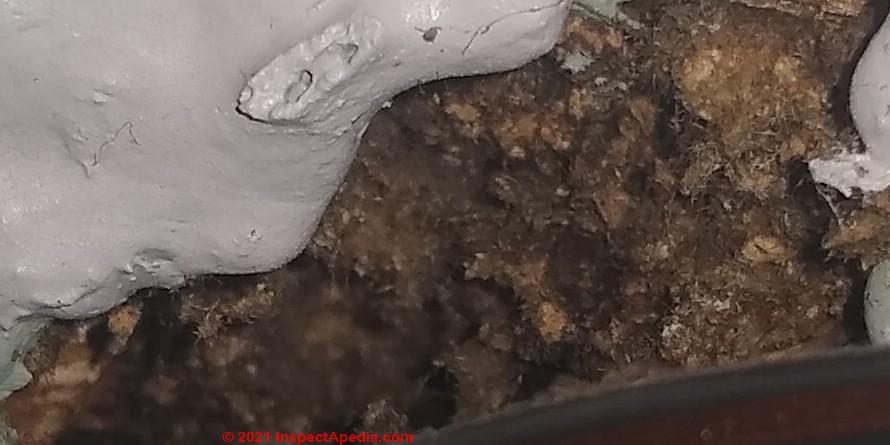
On 2021-04-21 by Nick
Reply by (mod) - ID fibrous insulation material in 1934 home
@Nick,
Sorry I can't make that out. It looks fibrous but I can't tell if I'm looking at a wood fiber material or something else.
Please post a sharper photo and we can probably identify that material.
Does this blown-in insulation contain asbestos?
Hi - Could this [photo above] blown-in insulation sample contain asbestos? It came out of the wall cavity of a 60s add-on during a recent rewire in our home (Cincinnati, OH). - On 2021-04-15 by a barrett -
Reply by (mod) - loose cellulose insulation
@a barrett,
Not likely, to me that looks like celluloseFollowup by a barrett
When I zoom in, I see pieces of print (numbers), flecks of pink & blue, and lots of fibers. Your insight is greatly appreciated - thank you!
Reply by (mod) -
@a barrett, that's great, confirming it's chopped newsprint or similar paper- thanks for the follow-up; that'll help other readers.
also See CELLULOSE LOOSE FILL INSULATION for details.
https://inspectapedia.com/insulation/Cellulose_Insulation.php
Can you identify this white foam insulation
Does anybody know what this type of foam insulation is?
We discovered it in the walls of our home and cannot seem to find anything about it.
It’s very lightweight and crumbles to dust with just a touch. We discovered that when water is sprayed on it it dissolves like sugar. - On 2021-04-06
by Jacueline Sinclair -
On 2021-04-06 by (mod) - fragile, crumbly foam insulation, 1970s UFFI
@Jacueline Sinclair, I can't make out much in the photo as it's rather blurry, J.
From your description that looks like 1970's era blown-in UFFI Insulation.
See examples at UFFI INSULATION IDENTIFICATION
but some clues you could offer would permit a reasonable guess:
Clues help guess at foam-type building insulation age and identification:
1. in what country and city are the house located?
2. How old is the building?
3. What's an estimate of when the insulation was added? At original construction, later, what decade?
3. Was the insulation sprayed in open wall cavities (in which case it doesn't fill out to the room-side of the studs perfectly or if it does you'll see saw kerfs where it was trimmed;
or
Was the insulation sprayed into enclosed wall cavities - in which case it usually fills them tightly though on wall demolition we sometimes find voids where blocking in the wall impeded insulation flow
4. Are there cut marks or holes or plugs showing where insulation was pumped from the interior or exterior of the building?
5. If you press on the insulation does it crumble to dust? If it's quire fragile - as you describe - see UREA FORMALDEHYDE FOAM INSULATION, UFFI inspectapedia.com/insulation/UFFI_insulation.php
or if it is spongy and hard, that is it's not fragile nor easily crumbled - see this example: URETHANE FOAM INSULATION at https://inspectapedia.com/Energy/Polyurethane_Insulation.php
Identify this gray insulation in a 1981 kitchen wall
Hello! Trying to identify this insulation found behind a kitchen wall. House built in 1981
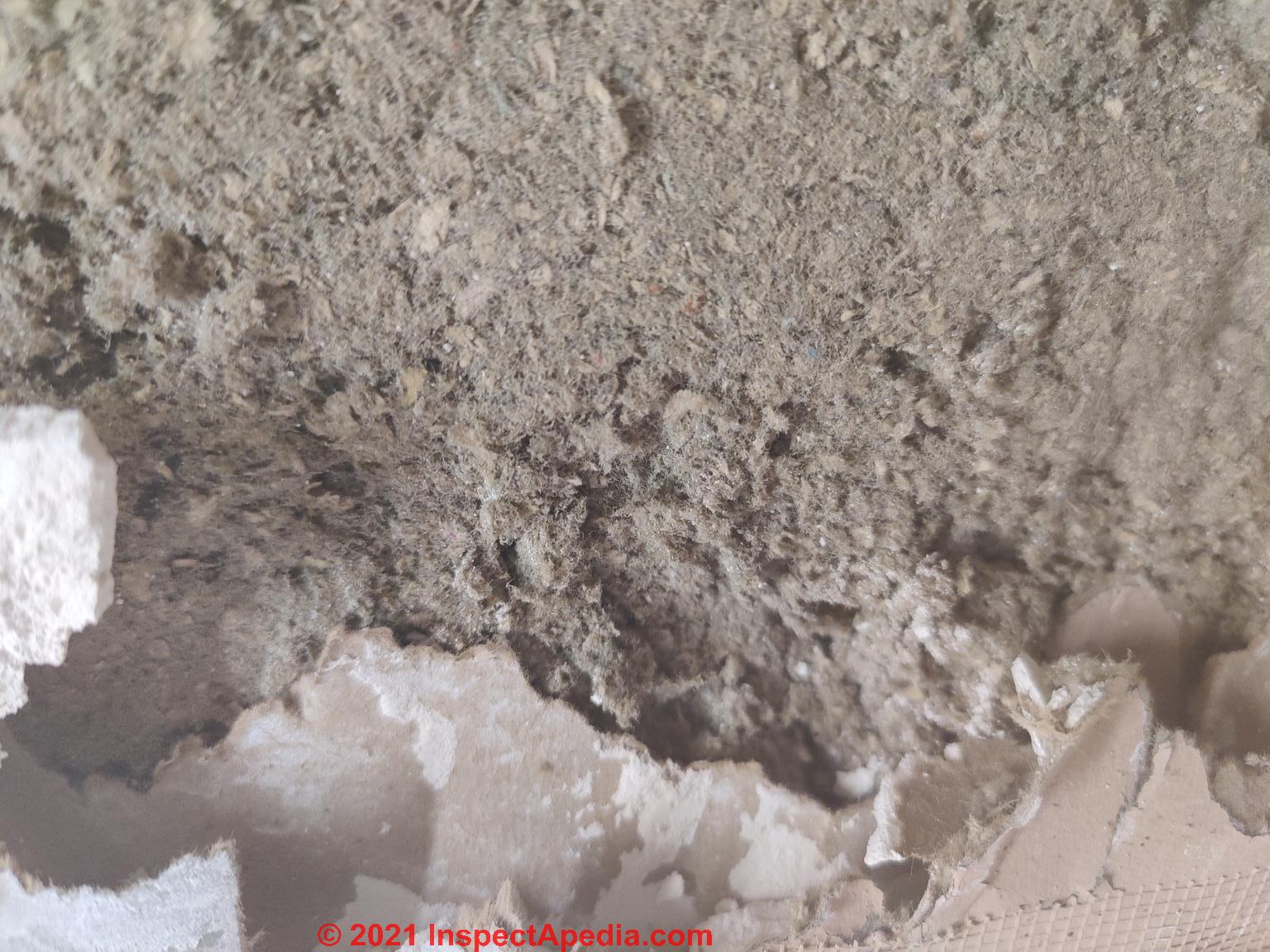
- On 2021-04-03 by Amy
Reply by (mod) - 1981 insulation, gray, probably cellulose
@Amy, That looks like tightly packed blown in cellulose insulation.
If it is it's probably made from chopped newsprint and often if you look very closely you may even find small bits of paper with letters on them.
What can fool us in identifying cellulose building insulation is that it may be blown-in so as to be tightly-packed, making recognition of individual paper fragments a bit more difficult until you loosen the material and use a magnifying glass.
Also some cellulose insulation includes shredded paper fibres.
What's this insulating material?
On 2021-02-20 by Brittany Rodgers
Reply by (mod) -
@Brittany Rodgers,
I'm guessing that you are asking for a guess at what that insulation is - the photo isn't too sharp: It could be finely-chopped cellulose (newsprint) but I think I see more-coarse, shiny fibres - if so it's probably a mineral fibre like Rock wool.
If it's dusty soft gray with bits of lettered paper, it's chopped cellulose insulation.
I think we see sawdust, or carpenter ant frass, and perhaps rodent droppings.
Can you post a sharper, larger image
What is this white insulation in a Pennsylvania home?
Additional picture 1890s home Pennsylvania - Photo above - On 2021-02-18 by Shaun -
Reply by (mod) - white mineral wool insulation from an 1890's Pennsylvania Home in the U.S.
Looks like white mineral wool or "rock wool" insulation. Or possibly white fiberglass -
but mineral wool usually has more gray in it. I see some gray filaments and some dark inclusions in your insulation; if those are not soiling from the insulation's history then those details argue for mineral wool or slag wool insulation.
This Q&A and more photos fro Shaun are found now in
our full article on the topic
at MINERAL WOOL - ROCK WOOL INSULATION
Compare this insulation with
and with
Identify this yellow-tan chopped up attic loose fill insulation
My house was built in 1940. Is this mineral wool or something else? Is it safe or Should I have it removed?
it appears to just be loose particles in the attic. - On 2021-02-13 by Dan
Reply - by (mod) - tell us where the insulating material was found and in what form: boards, batts, loose-fill: to help identify it
Looks like yellow fibrous insulation but the photo is a bit blurry so on enlargement I can't tell if I'm seeing mineral fibres or a wood product.
It would help plenty if I could know where this material was found and in what form it was found.
E.g. if this is from a soft insulating board then it's likely to be a plant or wood product.Best guess: mineral wool insulation
What's this gray attic insulation and does it contain asbestos?
Trying to find out what type of insulation this is and if there should be concern for asbestos. Found in attic.
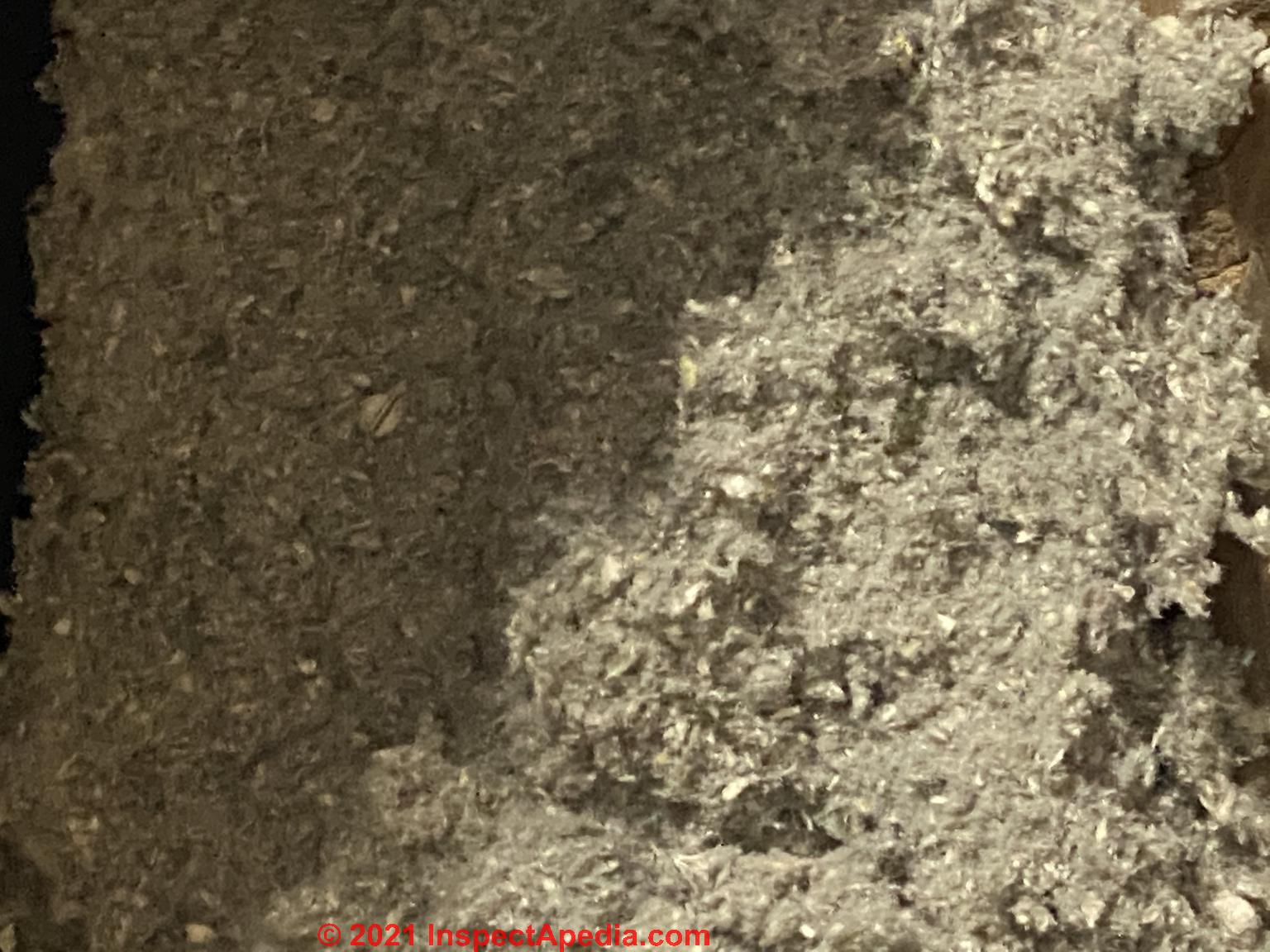
On 2021-01-26 by Sandy W.
Reply by (mod) - Cellulose insulation - notice that newsprint?
Sandy
That is loose fill or blown-in cellulose (paper) insulation. That's not an asbestos product.
In the article above see
CELLULOSE BUILDING INSULATION
What is this hard white Insulation in my 1948 New Jersey house?
Can anyone identify this insulation? Found in a house in New Jersey built around 1948, unclear if this is original insulation
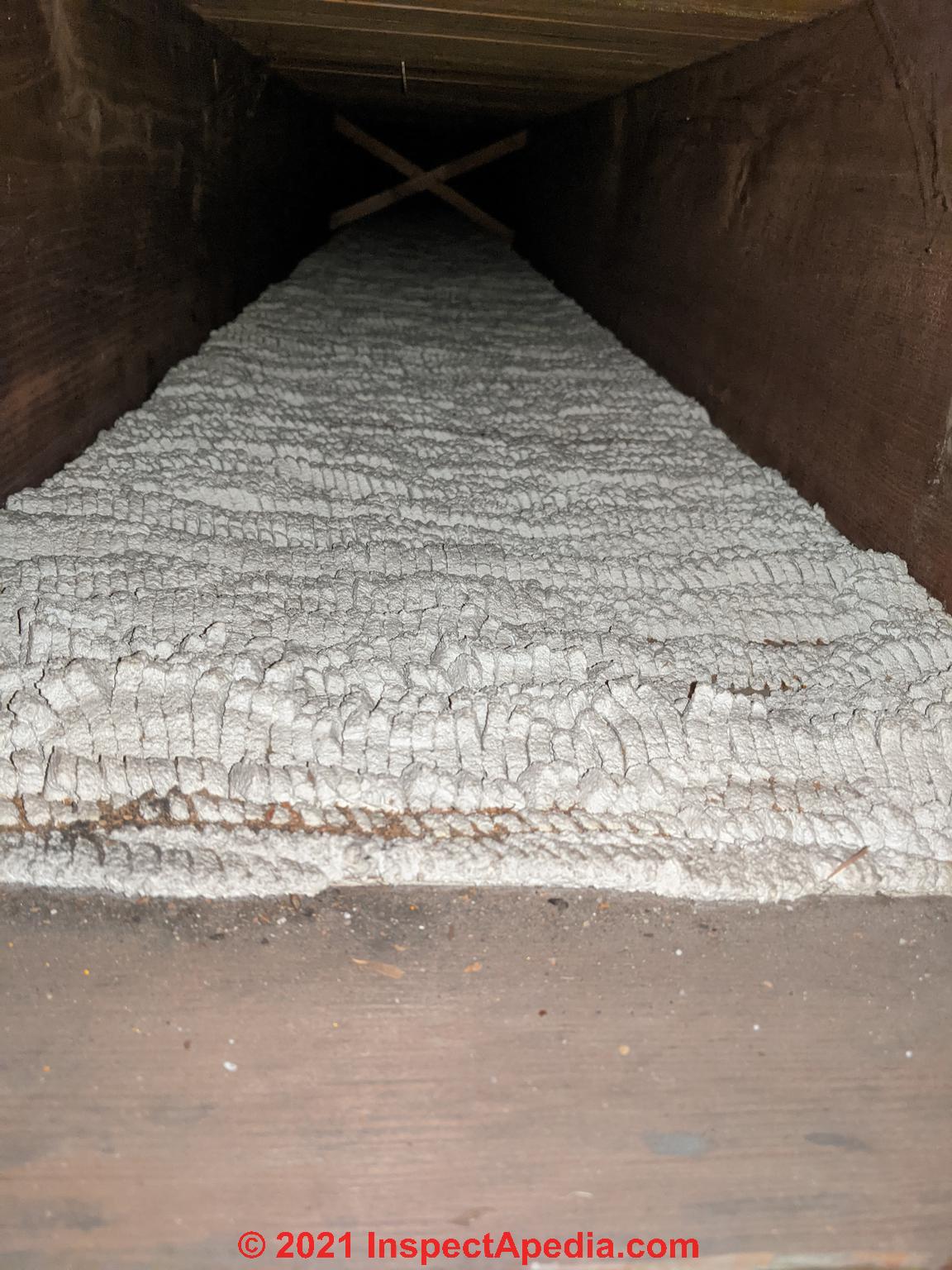
On 2021-01-16 by Andrew -
On 2021-01-16 by (mod) - plaster through expanded metal lath, no insulation
Andrew that's not insulation; you are showing in your photo the upper-surface of a expanded metal lath plaster ceiling. That's plaster.
Identify this gray-brown papery insulation in my home
Trying to identify this insulation in an attic space and odds that it contains asbestos.
House is in US originally built in 1946; could be original insulation for all I know. Was under some tar paper over the ceiling joists, but that's mostly deteriorating as well. - On 2021-01-04 by JJ
On 2021-01-04 - by (mod) -
That looks like a form of cellulose-paper insulation but
let's open that material up to look inside to be sure we're seeing insulation and not ...
Watch out: it also looks a heck of alot like a hornet's nest was built in your building so explore with great care.Then also see KRAFT PAPER INSULATION CREPE KIMSUL
Is there asbestos in the insulation of my old double walled steainless steel chimney?
Hi there,
My roof was recently replaced and I have a fireplace with a double-walled stainless steel metal chimney that I wanted to get rid of as I don't use the fireplace anymore. [see photo above - Ed.]
The roofers were able to take off the chimney, but part of the flue was sticking out that they couldnt get off, so they decided to break it off.
In between the walls of the metal flue was this light grey material that seems to crumble to dust if you touch it. It seems to have small fiberglass strands but I'm worried it might be asbestos. My home was build in Canada in 1987. Thanks! - On 2021-04-05 by Matt Y -
On 2021-04-05 by (mod) - treat pre 1986 insulated chimney cemetious material as "PACM" - Presumed Asbestos Containing Material - or test it
@Matt Y,
The insulation from an older metal chimney might NOT contain asbestos but some of those products did, so:
Watch out: While no one can start with complete confidence that the material you describe as asbestos, I can tell you from the context and information in your note that it was common to use a cemetious form of asbestos, perhaps mixed with other fibres, as the interior insulation in insulated metal chimneys up to about 1986 (in North America).
In sum, Asbestos-Insulation was widely used in multi wall insulated metal chimney flue's. So it'd be prudent to treat your material as asbestos-containing or have a sample tested.
The asbestos suspect material should be cleaned-up using damp wiping and HEPA-vacuuming. Wear PPE and take care not to spread asbestos dust and debris around the home.IF you find that there is more than a trivial amount of cleanup to be done, such as if the chimney insulation was spread through an attic, then professional cleanup services are probably needed. And depending on where you live, special rules and permits and licensing for cleanup and disposal of hazmat waste might apply.
On 2021-04-06 by Matt Y - insulation sample sent to asbestos test lab
Hi there, thank you for your reply and information. I have sent this sample off to a lab for analysis so we can know for sure what the substance is.
Some additional information I found:
The old home owner said they had the chimney replaced after they moved in (the late 90s).
If that is the case, does this change your opinion about this? I'm not sure if replacement of the stainless steel chimney also comes with the replacement of the stainless steel flue that was sticking out of the roof (which is where this material was found in).
I will post a comment again in ~2 weeks once I get the result back. In the meantime, I have sealed off my fireplace temporarily using cardboard and tuck-tape until I know for sure.
Thanks again!On 2021-04-07 by (mod) - an insulated metal chimney installed in the 1990s in North America won't contain asbestos
@Matt Y,
Thank you, yes, that changes my opinion;
For insulated chimneys sold in the U.S. after 1986 it's less likely that asbestos was used as the insulating filler. IF you can find a manufacturer's label it would be helpful to see a photo of that.
Do keep me posted - your result will be helpful to others
On 2021-04-23 by Matt Y - lab report confirms cementious gray-white insulation in a 1990s insulated chimney: not asbestos
I'm happy to report that it is not asbestos - turns out it is 15% Glass Fibers, attached photo of the lab report.
Thanks again,
MattOn 2021-04-24 by (mod) - white powdery insulating material - not asbestos!
@Matt Y,
Thanks for that follow-up - it will certainly be of interest to other readers.
Good news; reviewing the history of our conversation, looking at a 1990s insulated chimney insulation in North America, it'd likely be a product that that substituted fiberglass for asbestos long fibres and that must include some other paste or inorganic material to make up the bulk of the substance
...
Continue reading at INSULATION IDENTIFICATION GUIDE - topic home, or select a topic from the closely-related articles below, or see the complete ARTICLE INDEX.
Or see these
Recommended Articles
- FOAM SPRAY INSULATION TYPES
- INSULATION IDENTIFICATION GUIDE - home
- INSULATION IDENTIFICATION by COLOR / TEXTURE FAQs
- INSULATION INSPECTION & IMPROVEMENT inspecting and improving the level and effectiveness of insulation in buildings, advice on troubleshooting insulation problems.
Suggested citation for this web page
INSULATION IDENTIFICATION GUIDE FAQs3 at InspectApedia.com - online encyclopedia of building & environmental inspection, testing, diagnosis, repair, & problem prevention advice.
Or see this
INDEX to RELATED ARTICLES: ARTICLE INDEX to BUILDING INSULATION
Or use the SEARCH BOX found below to Ask a Question or Search InspectApedia
Ask a Question or Search InspectApedia
Try the search box just below, or if you prefer, post a question or comment in the Comments box below and we will respond promptly.
Search the InspectApedia website
Note: appearance of your Comment below may be delayed: if your comment contains an image, photograph, web link, or text that looks to the software as if it might be a web link, your posting will appear after it has been approved by a moderator. Apologies for the delay.
Only one image can be added per comment but you can post as many comments, and therefore images, as you like.
You will not receive a notification when a response to your question has been posted.
Please bookmark this page to make it easy for you to check back for our response.
IF above you see "Comment Form is loading comments..." then COMMENT BOX - countable.ca / bawkbox.com IS NOT WORKING.
In any case you are welcome to send an email directly to us at InspectApedia.com at editor@inspectApedia.com
We'll reply to you directly. Please help us help you by noting, in your email, the URL of the InspectApedia page where you wanted to comment.
Citations & References
In addition to any citations in the article above, a full list is available on request.
...
- Carson, Dunlop & Associates Ltd., 120 Carlton Street Suite 407, Toronto ON M5A 4K2. Tel: (416) 964-9415 1-800-268-7070 Email: info@carsondunlop.com. Alan Carson is a past president of ASHI, the American Society of Home Inspectors.
Thanks to Alan Carson and Bob Dunlop, for permission for InspectAPedia to use text excerpts from The HOME REFERENCE BOOK - the Encyclopedia of Homes and to use illustrations from The ILLUSTRATED HOME .
Carson Dunlop Associates provides extensive home inspection education and report writing material. In gratitude we provide links to tsome Carson Dunlop Associates products and services.



